A Guide to Exploring Trento and Its Surrounding Attractions
WanderInEurope is reader-supported. Affiliate links and ads help us keep creating useful content for you.
Traveling in Italy feels like a fascinating experience—the further north you go, the more the landscapes change. Starting in Rome or Florence and heading toward Cortina d’Ampezzo in the Dolomites, the scenery shifts in a really noticeable way. By the time you reach Bergamo, Verona, Lake Como, or Lake Garda, the mountains seem close enough to touch.
People often think leaving the busy cities means there’s less history and culture to discover, but that’s not true in Northern Italy. Take Trento as an example. It’s surrounded by the Italian Alps but is packed with things to explore, from medieval castles to World War monuments. Let me share them with you here.
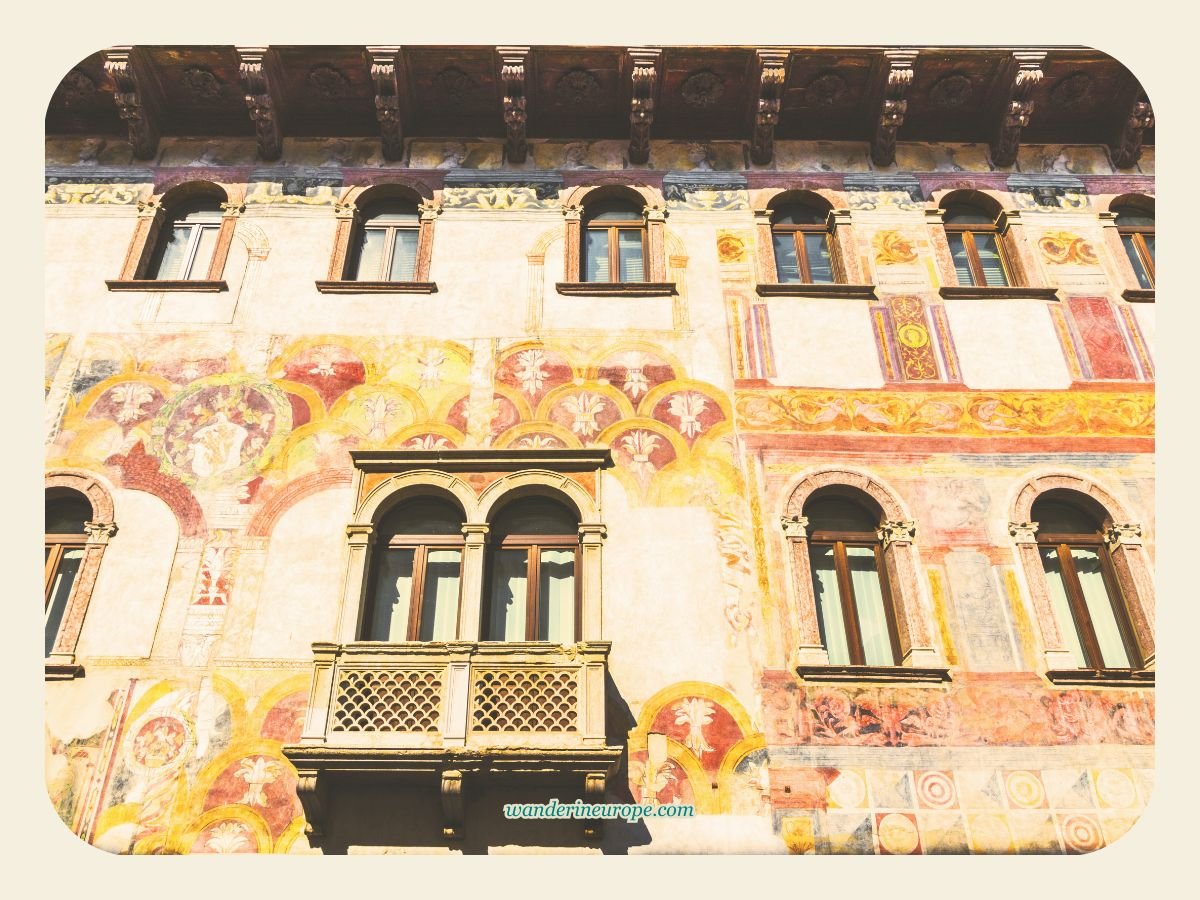
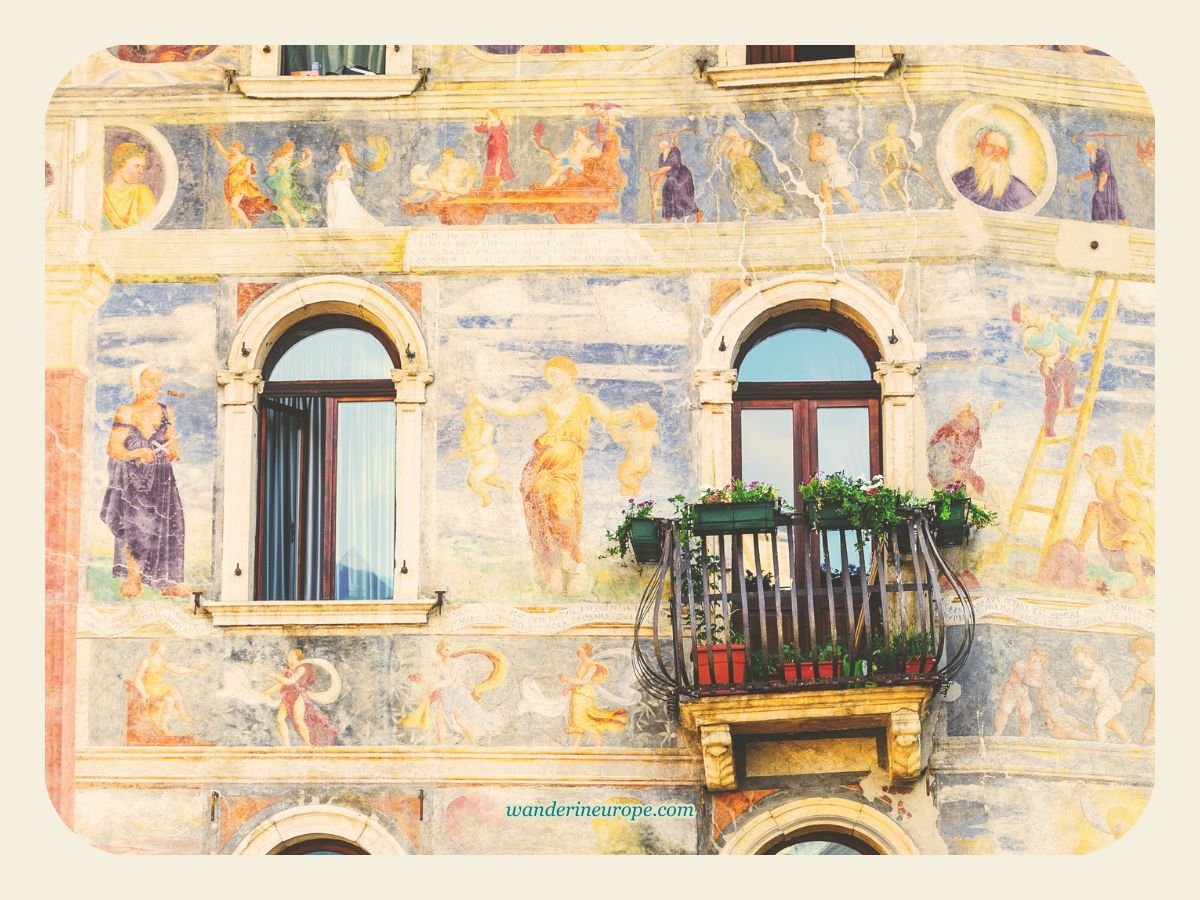
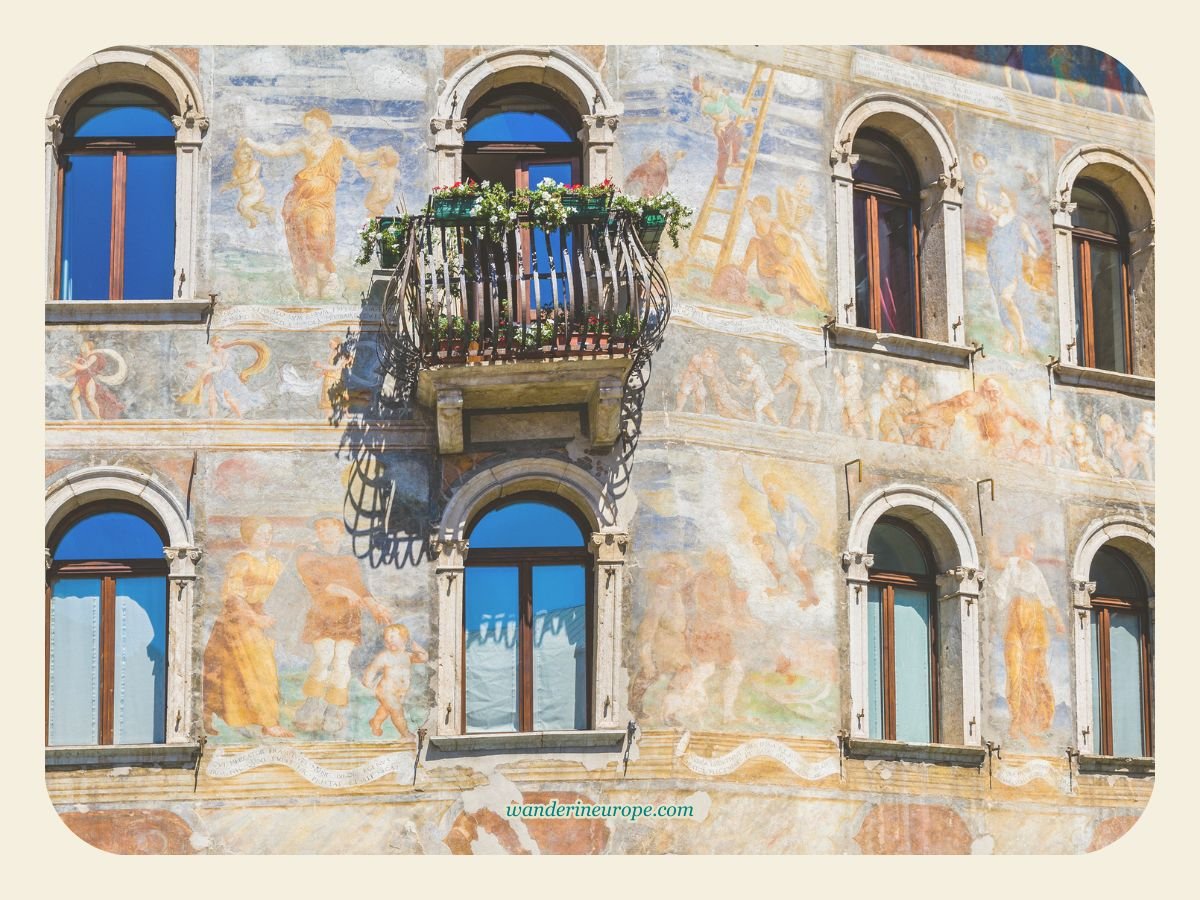
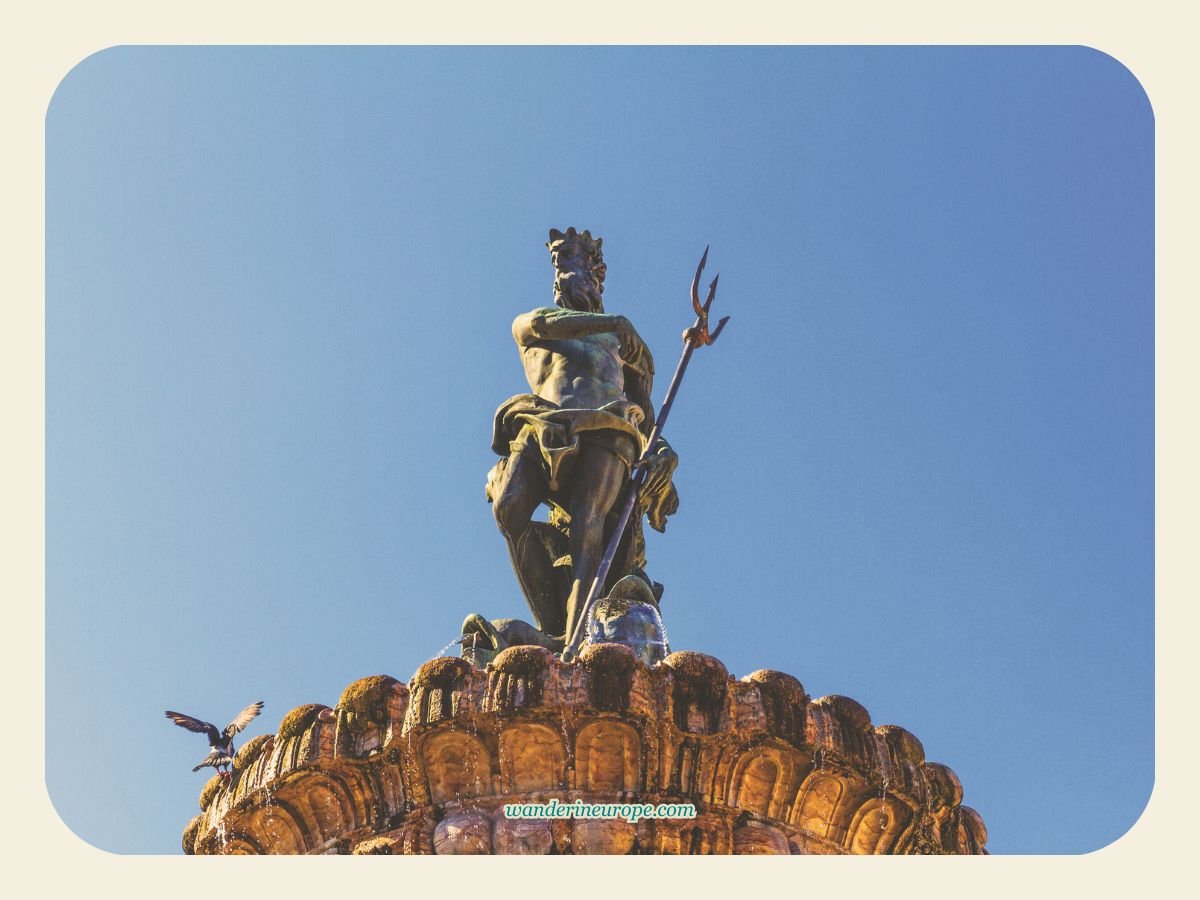
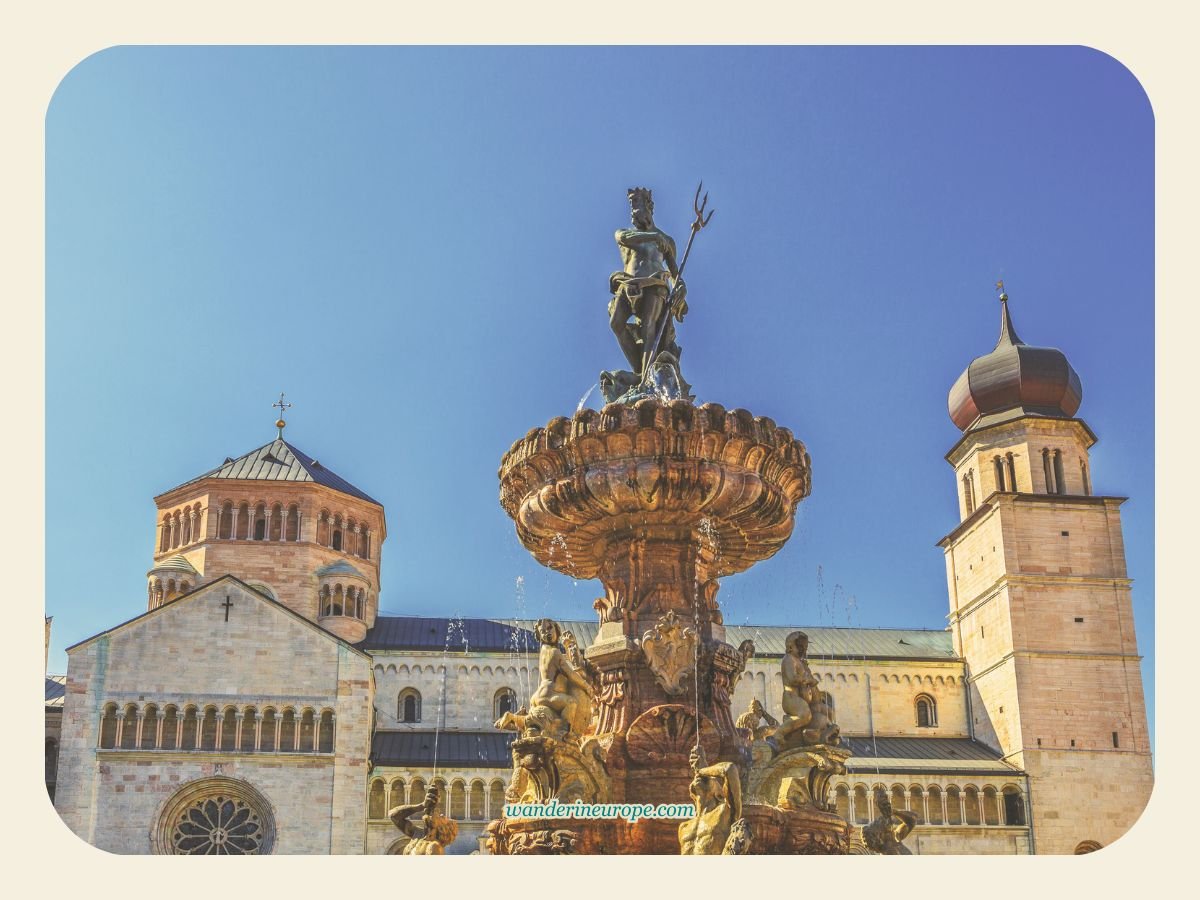
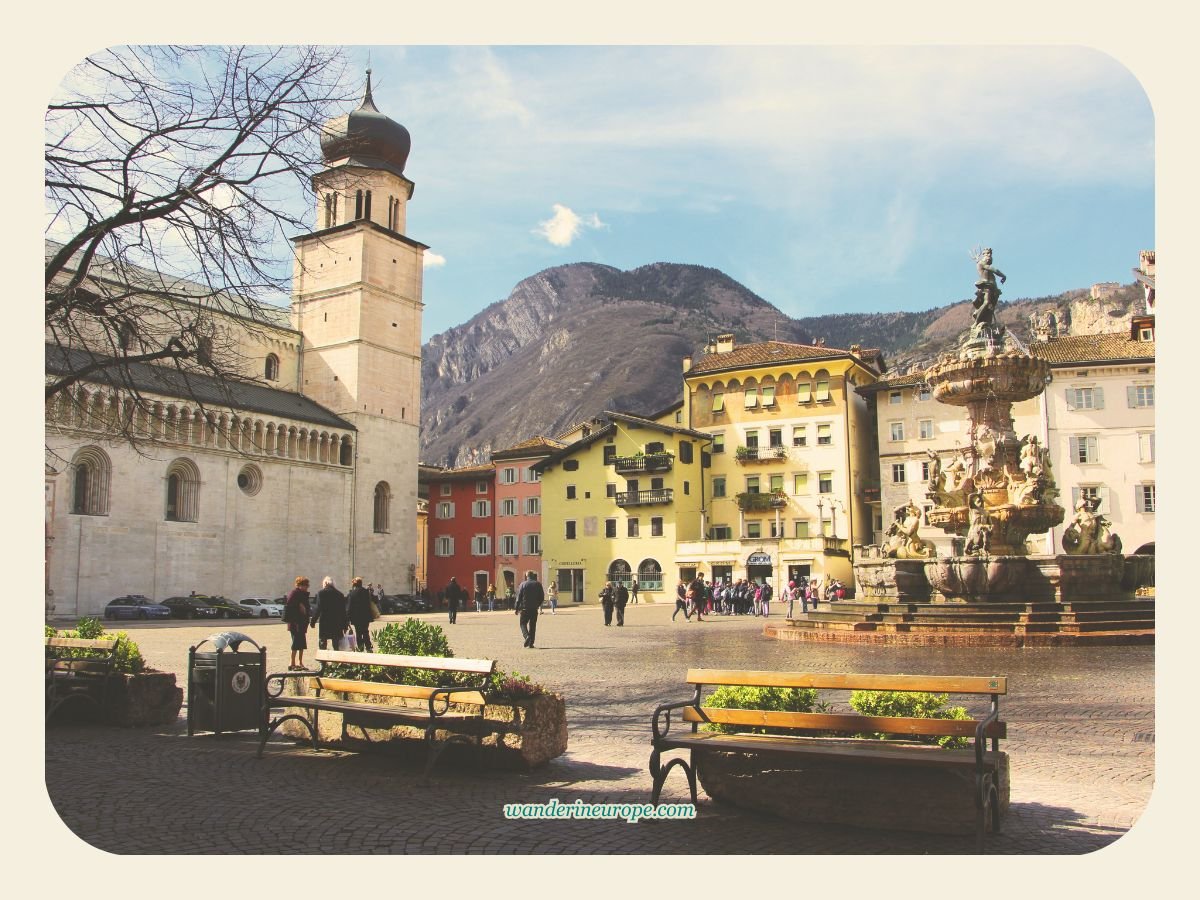
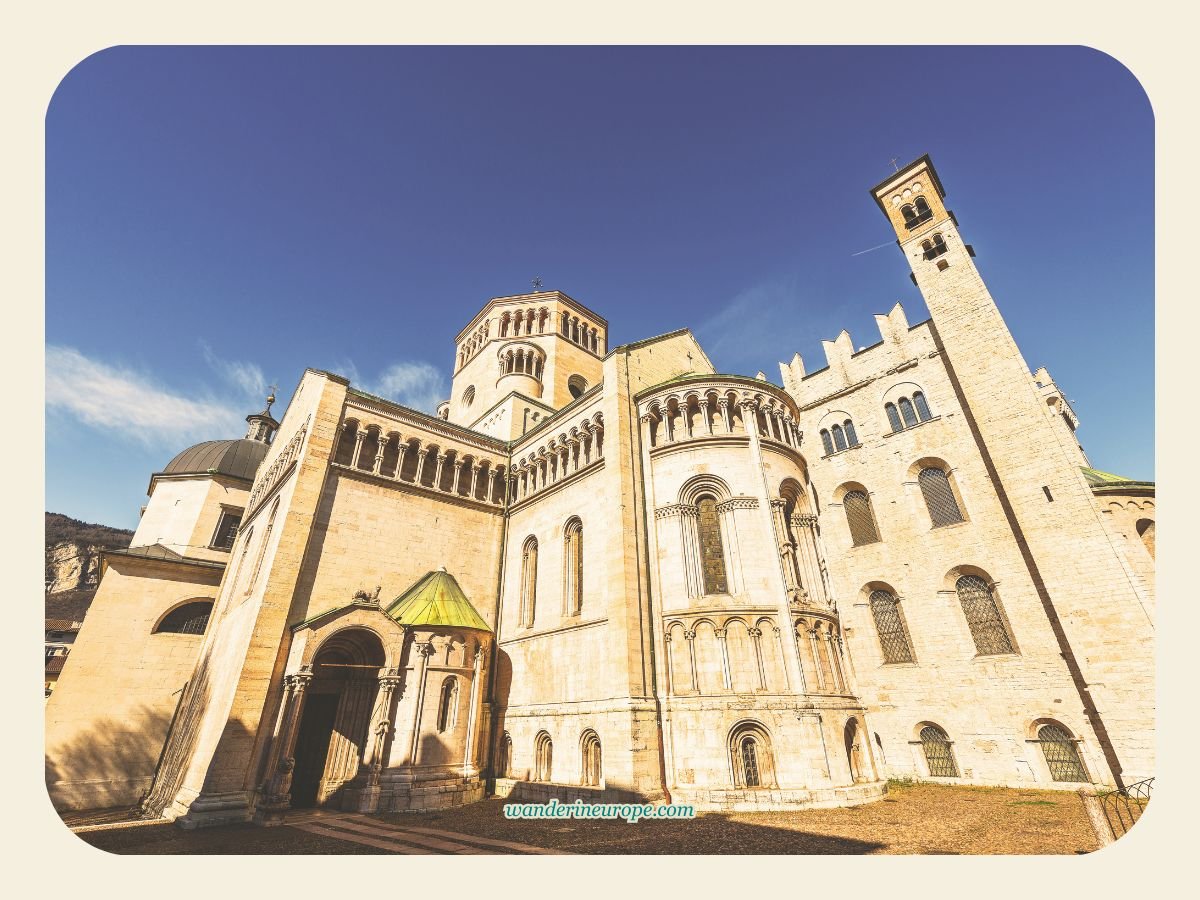
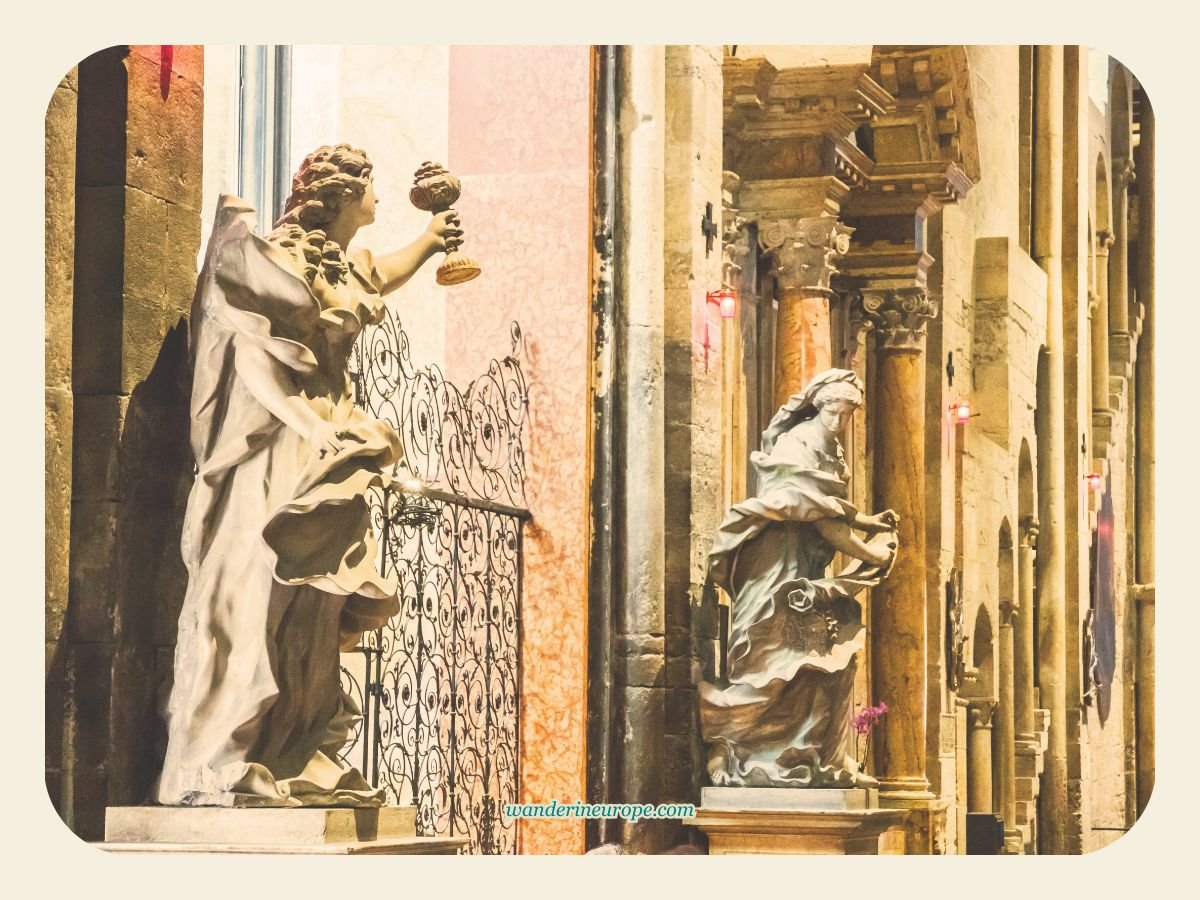
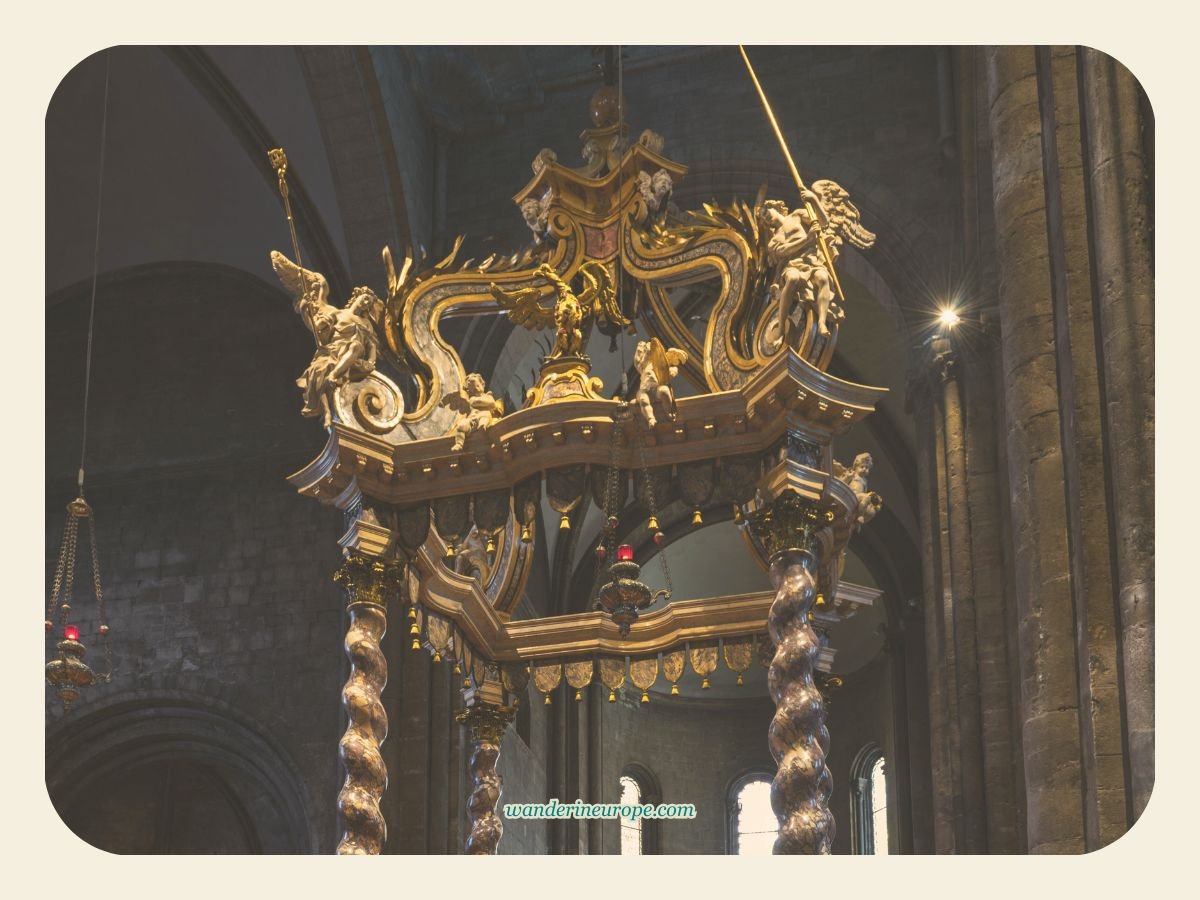

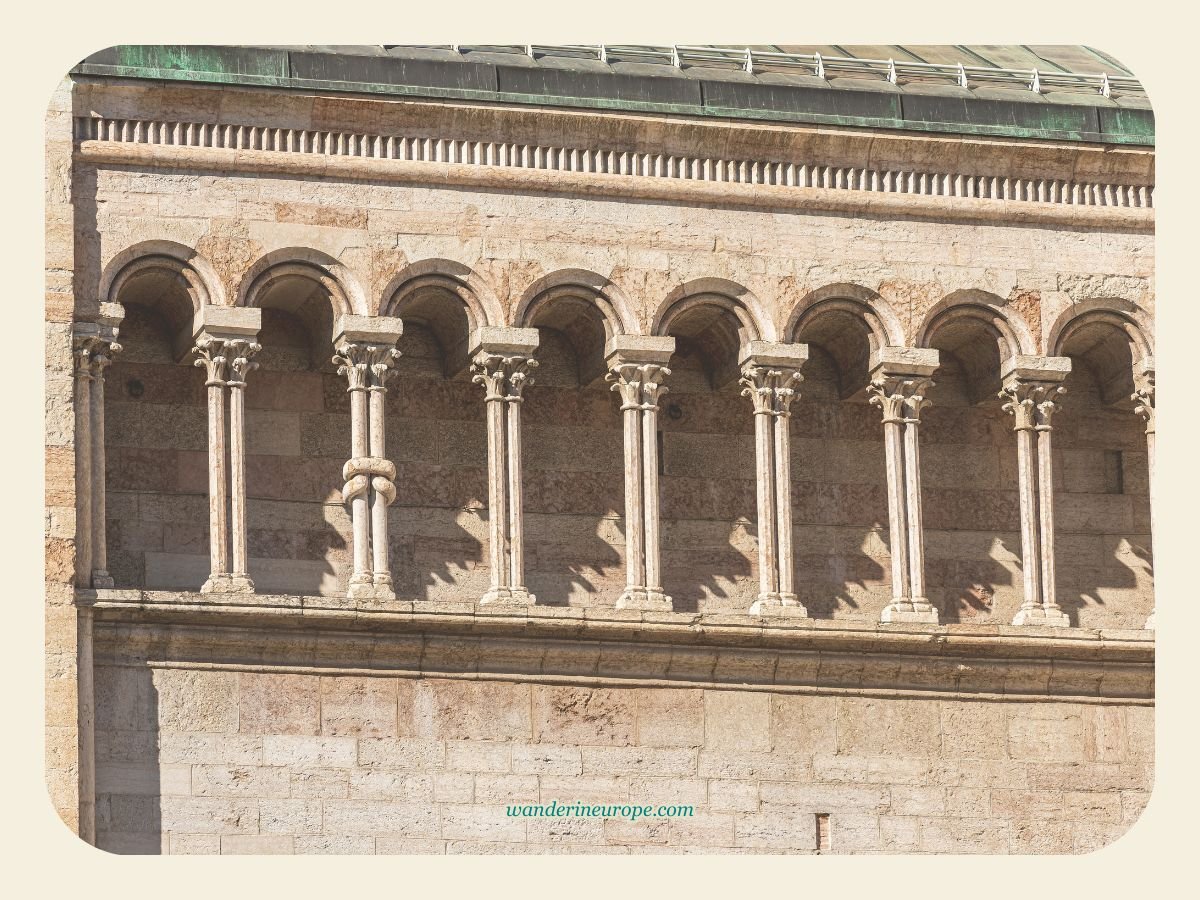

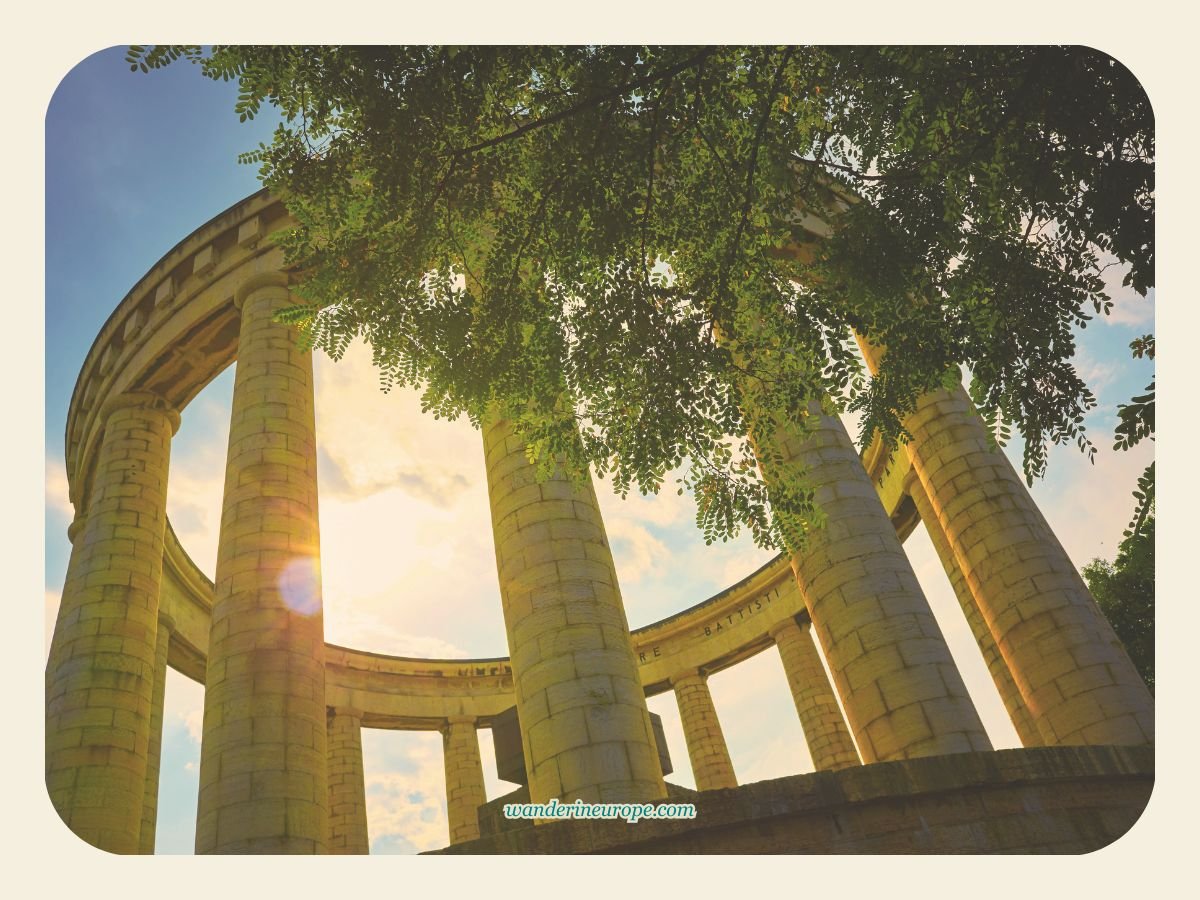
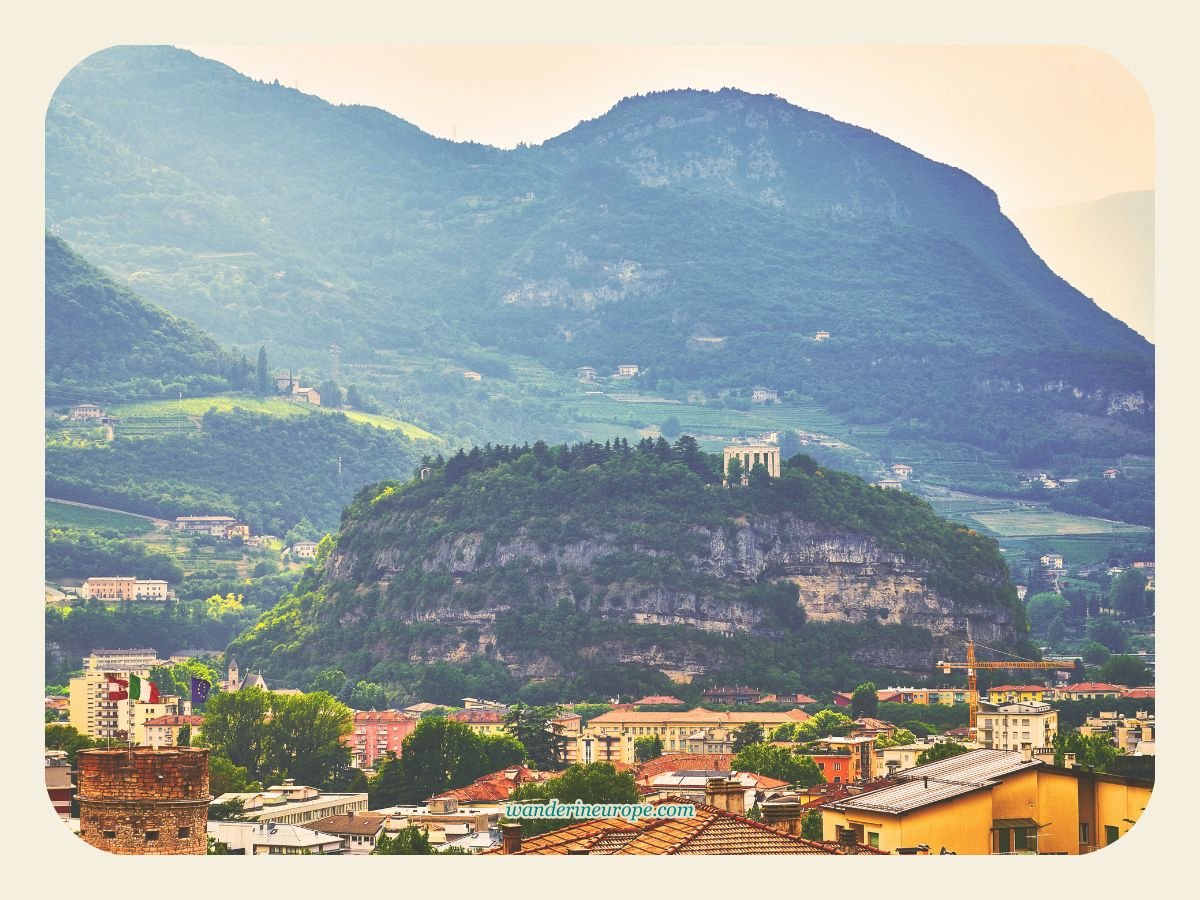
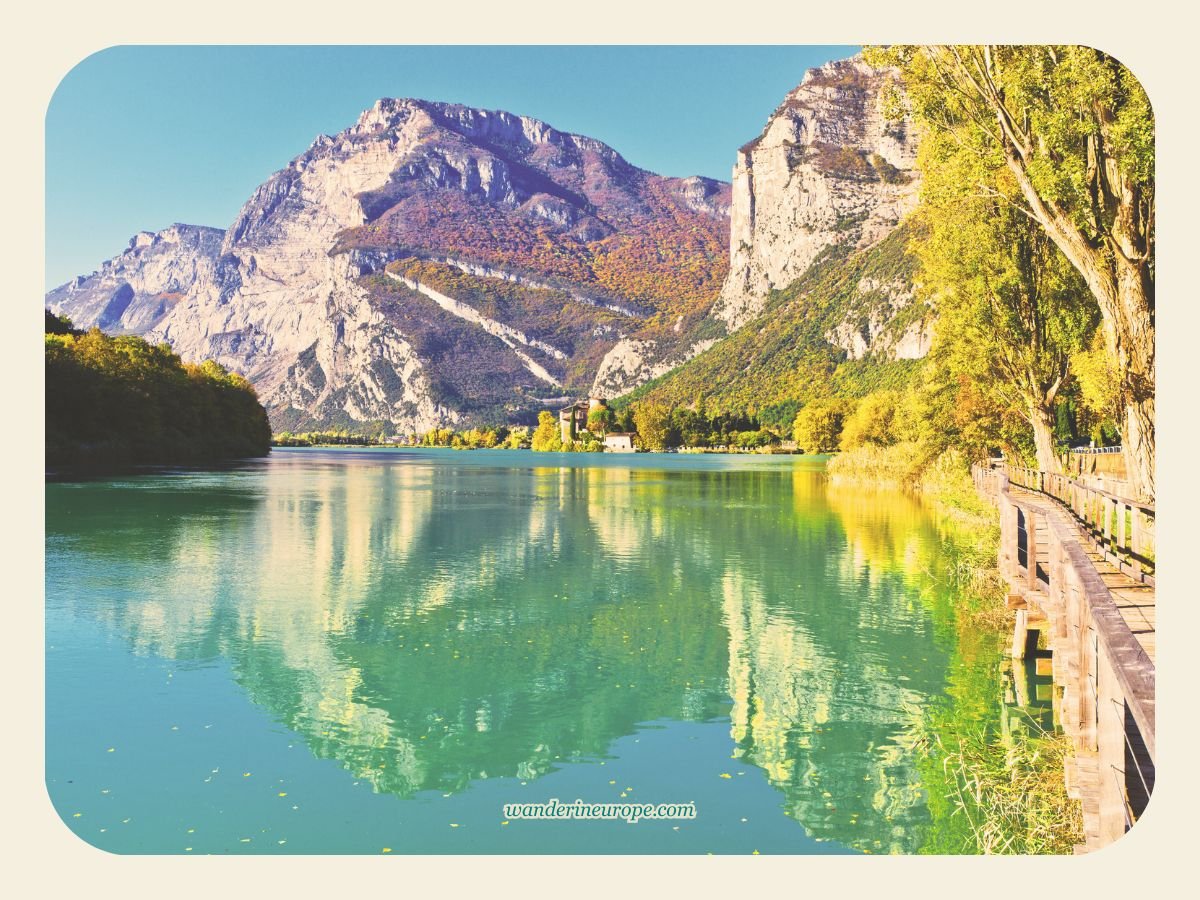
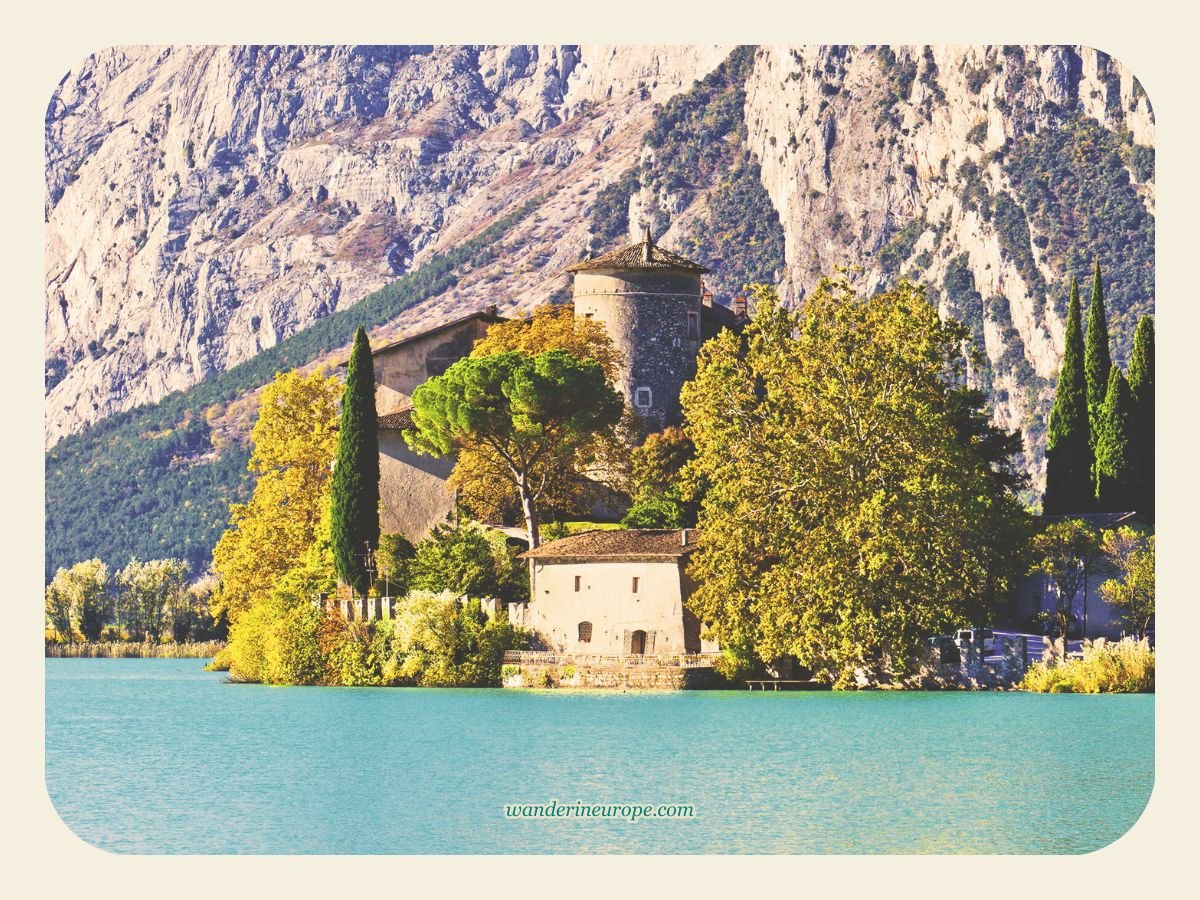

Top Things to Do in Trento
Here are the places and tourist attractions in Trento that are easy to reach from the city center. They’re all close together, so you can explore them on foot as you wander around the city.
Just a 7-minute walk from the train station is Piazza Duomo, the lively heart of Trento.
It’s a great place to kick off your Trento experience, especially if you skipped breakfast. The square is lined with cafes and restaurants where you can grab a bite before heading out. There’s more than just food, though. The Piazza offers plenty to see, with some of Trento’s most important and beautiful buildings. Even better, you can explore it all for free!
Swipe the 360-view image to see the entire Piazza Duomo:

Fountain of Neptune
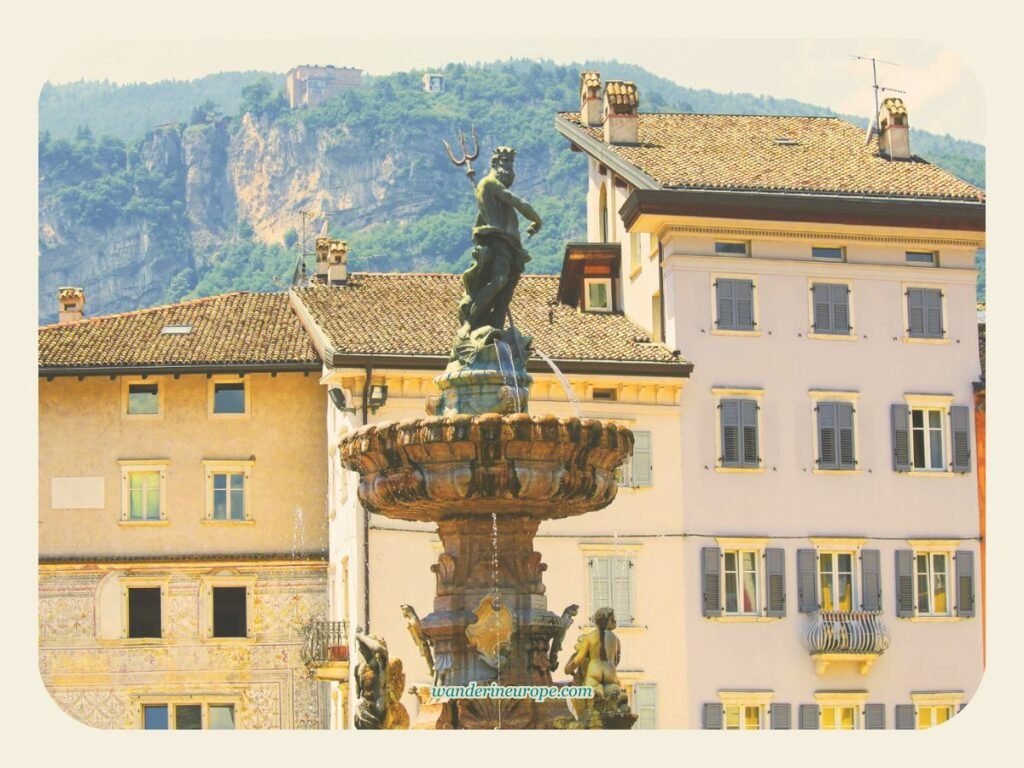
At the center of Piazza Duomo stands the impressive Fountain of Neptune, which has been a focal point of the square for over 250 years. Its water has stayed fresh and clean thanks to an old rule that requires everyone to keep it that way. This iconic fountain is a popular photo spot for tourists capturing their Trento memories.
Feel free to snap your own pictures, but no hand-washing allowed! 🙂
Cathedral of Saint Vigilio
Just south of the fountain is the Cathedral of Saint Vigilio, rich in Catholic Church history. The cathedral’s size is impressive, and while most of its exterior—except for the Apse—is fairly simple, the facade really catches the eye. We’ll explore the treasures inside the cathedral later on.
Palazzo Pretorio and Torre Civica
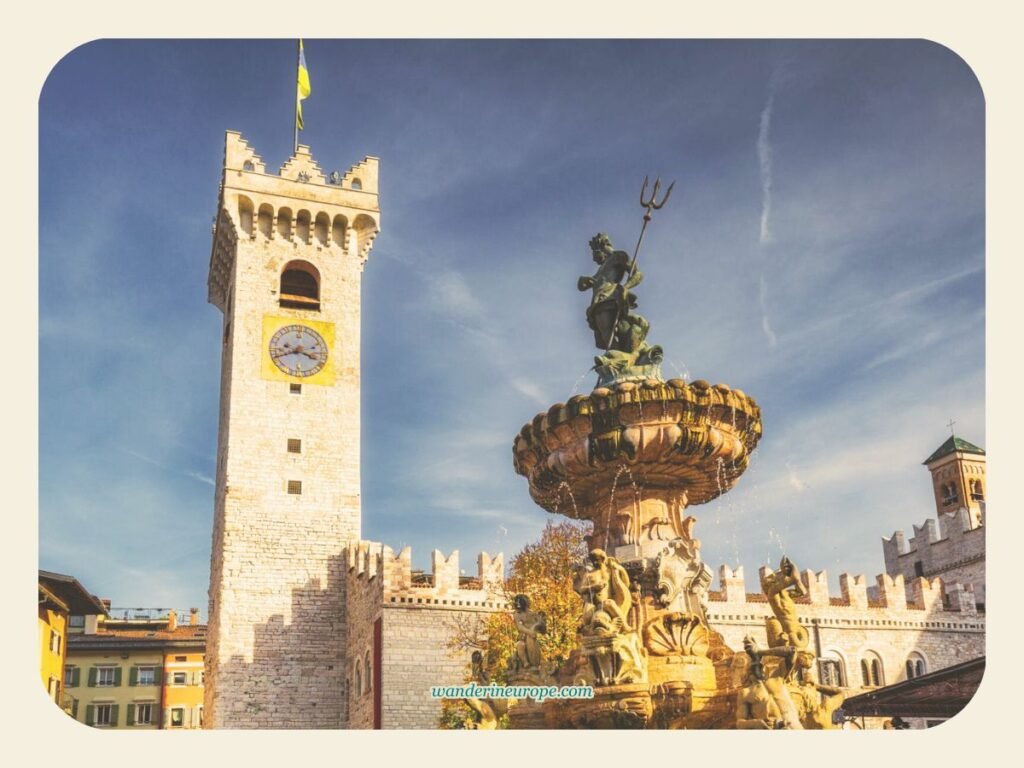
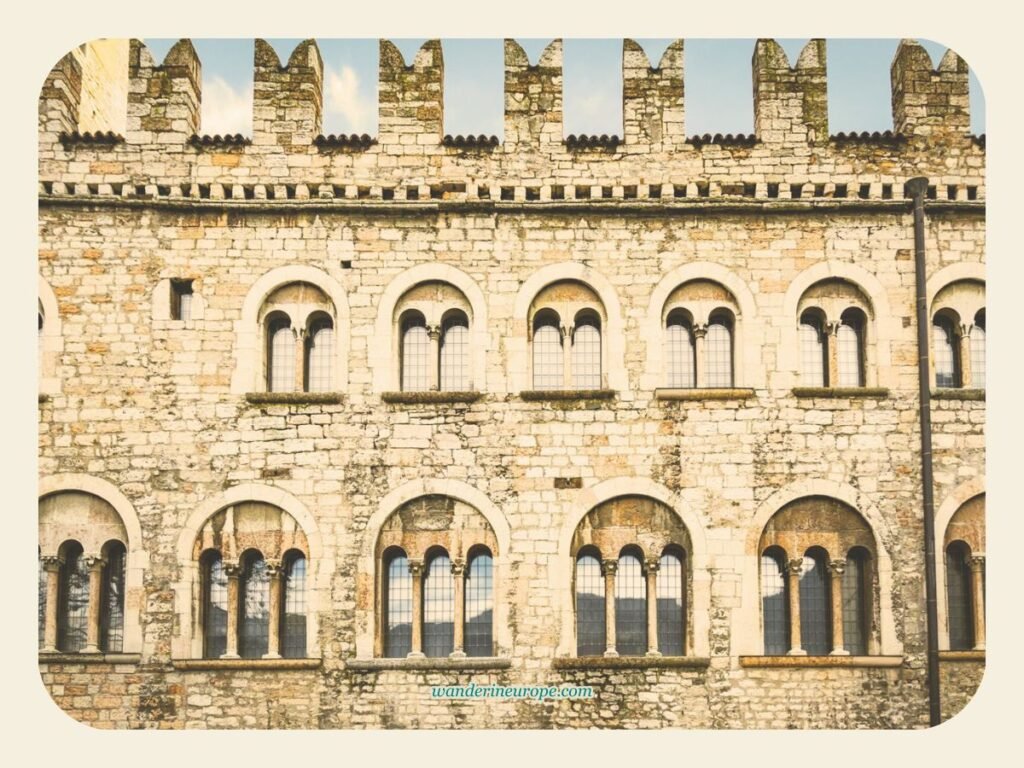
Next to the Cathedral of Saint Vigilio are the Palazzo Pretorio and Torre Civica, which used to house the city’s bishop princes and administrative tribunals. Today, they’re home to the Tridentine Diocesan Museum, where you can explore the artistic history of the Trento Diocese.
The museum’s highlight is its artwork centered around the Council of Trento. You’ll also find a large collection of items from the 12th to 19th centuries, including liturgical vestments and impressive weavings. Personally, I find the cathedral’s illuminated manuscripts the most fascinating. The early 16th-century Passion of Christ series by Pieter Van Edinghen is also worth checking out!
If you’re planning to visit the Tridentine Diocesan Museum, it’s a good idea to visit their official website first. You’ll find all the important details there, including announcements and entry rules.
Casa Cazuffi and Casa Rella
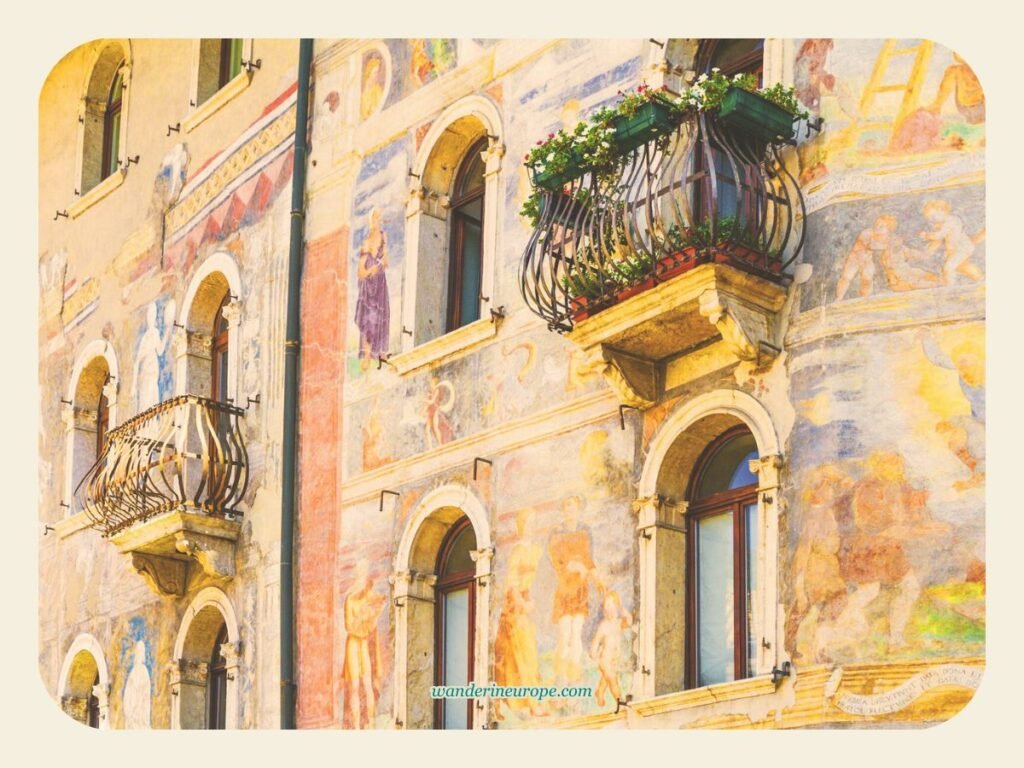
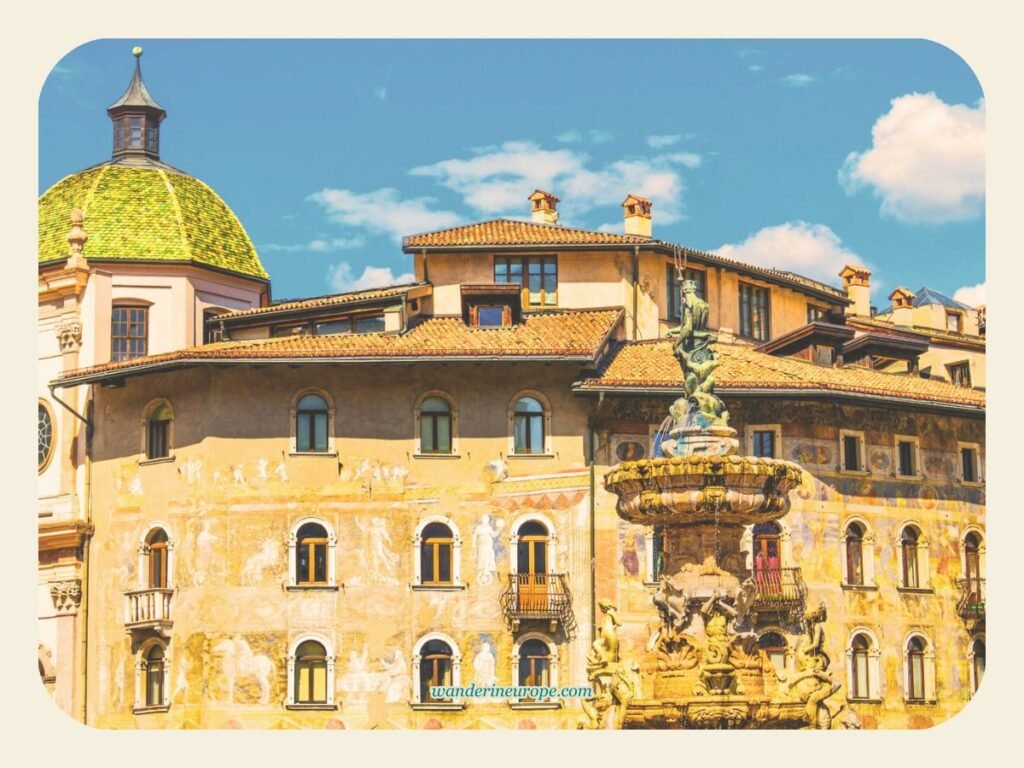
Lastly, make sure to check out the two unique houses just north of Piazza Duomo, near the Torre Civica. Called Casa Cazuffi and Casa Rella, they have murals inspired by the Lüftlmalerei style, which is common in Tyrol, Austria, and southern Germany.
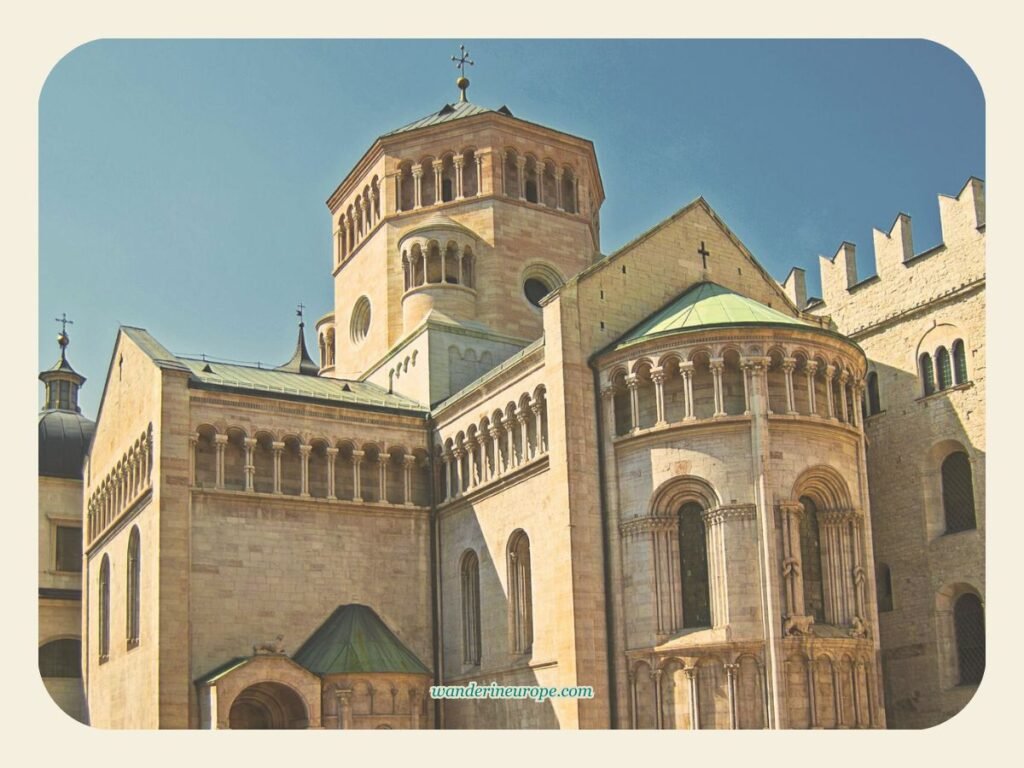
Originally built in the Romanesque style, Trento Cathedral, also known as the Cathedral of Saint Vigilio, underwent several changes over its five-century-long construction, which began in the early 13th century. One notable feature is the statue of the Madonna degli Annegati (Madonna of the Drowned).
While it may look like an ordinary church from the outside, there are plenty of surprises inside for those who take a closer look.
The most notable thing about the Trento Cathedral is that it hosted the mid-16th century Council of Trent, an important ecumenical meeting of the Catholic Church that addressed challenges raised by Protestantism. To get a sense of this historic event, you can see a painting of the council inside the cathedral.
But there’s more to explore. The interior is filled with religious artwork, frescoes, and Byzantine-style murals that give a glimpse of the past. Be sure to check out the side altars, the staircase, and the cathedral crypt. Explore the crypt here:

If you’re planning to stop by, make sure to check Trento tourism’s official website for opening hours and announcements.
If you’re looking for a historical site to visit in Trento, I recommend checking out Buonconsiglio Castle. Inside, you’ll find collections from different eras that give you a glimpse of the past. With its medieval look and impressive treasures, it’s definitely worth visiting.
Just a short walk from the city center, this castle-turned-museum was once home to prince-bishops, similar to the Palazzo Pretorio. The castle is divided into four main sections, each with its own theme, so there’s a lot to explore. Plan to spend at least 3-4 hours to take it all in.

The four parts of Buonconsiglio Castle are:
The Old Castle, or Castelvecchio, was the first section of Buonconsiglio Castle to be constructed. Built as a military fortress, it was positioned high above Trento to protect the city, offering a view of the River Adige. Castelvecchio’s Gothic doors, battlements, and defensive design create a fairytale atmosphere that transports you to the Middle Ages. Fans of medieval movies or TV shows will feel like they’ve stepped into one of their favorite scenes.
Check out the open gallery in the courtyard to see sculptures, inscriptions, and frescoes that offer a deeper glimpse into the castle’s history. My favorite part of Castelvecchio is the Venetian Loggia. It may be a small opening in the castle’s facade, but the views from there are truly unforgettable.
From the Venetian Loggia of Castelvecchio, you’ll see church spires and medieval towers rising against Trento’s skyline, with the peaceful Alps stretching in the distance. The view will make you feel like you rule the city, just as the prince-bishops once did.
Castelvecchio is the medieval section of the Buonconsiglio Castle Museum, located in its northernmost part. To its south lies Giunta Albertiana, the smallest section of the museum. This two-story structure connects Castelvecchio with the Renaissance-era Magno Palazzo.
Albertiana features frescoes and stuccoes that illustrate tales of war, religion, and mythology. Two standout pieces here are The Triumph of the Christian Faith and Minerva Banishing the Sins Back to Hell.
The Buonconsiglio Castle Museum houses numerous remarkable artworks, many of which are located in the Magno Palazzo. Every room is adorned with frescoes covering a variety of themes, such as mythology, religion, fashion, and human nature. These frescoes even illustrate the lavish lifestyles of the bishops who once lived in the palace and are present throughout, including the narrow corridors.
While Castelvecchio is known for the Venetian Loggia, the Magno Palazzo features the equally impressive Loggia del Romanino. Though it doesn’t provide the same expansive views, the Loggia del Romanino is undeniably picturesque. The natural light pouring in enhances the scene, making it, in my opinion, the most impressive part of the palace.
See the Loggia del Romanino in 360-view:

When you look up at the ceiling of the Loggia del Romanino, every inch is covered in frescoes. The centerpiece is the most striking—a depiction of Phaethon riding the sun chariot. Some frescoes use the Trompe-l’oeil technique, creating a 3D optical illusion that will leave you amazed.
As you walk through the halls of the Magno Palazzo, you’ll find yourself surrounded by remarkable frescoes in every room. But the experience doesn’t end there—at the southern end of the Buonconsiglio Castle Museum, you’ll discover the castle’s second and third towers, Torre del Falco and Torre Aquila.
These towers feature more incredible frescoes that capture the lives of medieval noblemen, showing them exploring the wilderness, hunting in scenic forests, and enjoying country life.
While both towers share a similar theme, Torre Aquila stands out as a highlight. It houses the famous fresco, Cycle of the Months, which portrays the passage of time and the changing seasons in a fascinating way.
Looking for something fun to do in Trento? Head over to Le Gallerie di Piedicastello, located just west of the Buonconsiglio Castle Museum on the other side of the Adige River. You can catch buses #1 or #6 from Buonconsiglio Castle Museum or Piazza Duomo for a convenient ride, but if the weather’s nice, consider walking since both spots are close by.
Le Gallerie di Piedicastello is a museum housed in a former tunnel, showcasing powerful photographs from the world wars along with historical military artifacts like weapons, tools, and flags.
Some of the old films and photos can be emotional, while others may feel unsettling. Although there are no English explanations, the visuals are powerful enough to tell the story on their own. The museum is split into two connected tunnels—the black tunnel and the white tunnel—both stretching for 300 meters. Best of all, admission is completely free!

Before you visit, check the Le Gallerie di Piedicastello website for any updates or important information.
Le Gallerie di Piedicastello is located beneath a hill called Doss Trento. As you get closer, you’ll spot a striking white circular building at the top of the hill. That building is the National Historical Museum of the Alpine Troops, which we’ll cover next as another great destination in Trento.
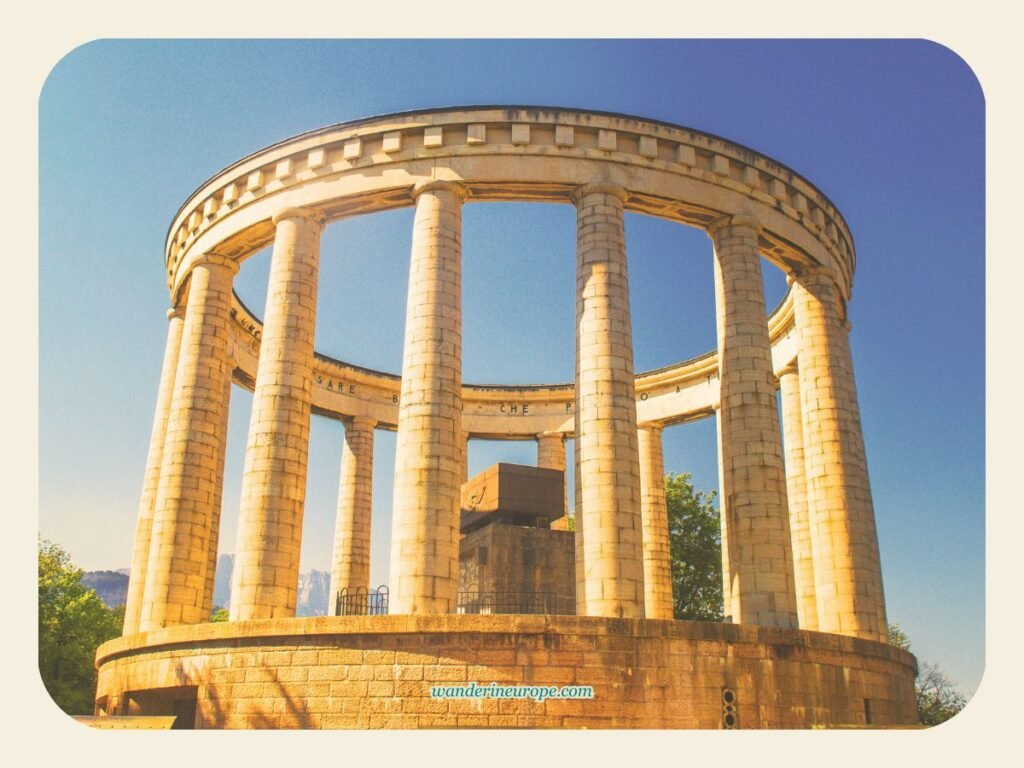
The National Historical Museum of the Alpine Troops in Doss Trento complements Le Gallerie di Piedicastello well. As the name suggests, it offers insight into military life in the Alps. You can hike to the top of Doss Trento in about 25 minutes from Le Gallerie di Piedicastello—just be ready for a lot of stairs.
If you prefer driving, it takes only 5 minutes, and a small parking area is available. To get there from Le Gallerie di Piedicastello, follow the road away from the roundabout or River Adige. Look for a sign on the right that says “to Doss Trento,” and you’ll be on your way up in no time.
The National Historical Museum of the Alpine Troops in Doss Trento offers a unique perspective on mountain warfare. Along with learning about the Alpini—the Italian Army’s specialist mountain infantry—you can take in sweeping views of the Alps and the city of Trento. The museum features a 1,400-square-meter park and displays the troops’ armory, awards, uniforms, photos, and paintings, providing a detailed look at their lives.
For extra inspiration, check out the movie The Silent Mountain (2014) before visiting.
Even if alpine warfare doesn’t interest you, the views from this site are worth the trip. From the top, you’ll get sweeping views of Trento and the snow-capped mountains beyond. It’s also one of the best places in Trento to take in the beauty of the Adige River.
As you explore the park, you’ll see cannons, statues of soldiers, and a white mausoleum that’s visible from the road to Doss Trento. You’ll also find the ruins of an old church, stone inscriptions, and plenty of natural scenery to satisfy your curiosity.

Just like Le Gallerie di Piedicastello, admission to the National Historical Museum of the Alpine Troops is free. It’s always a good idea to check the museum’s official website before you visit to see if there are any announcements or changes to their hours of operation.

If you want a peaceful way to enjoy nature in Trento, the bike and pedestrian paths along the Adige River are a great choice.
The path is wide and open, with the mountains around Trento creating a beautiful backdrop. It’s one of my favorite free activities in the area, and I recommend it to anyone looking to relax. The best part is that the path usually isn’t crowded, so you can enjoy the quiet and the calming sound of the river. The mountain views are the real highlight, adding a perfect touch to this peaceful walk.
The pedestrian path follows the east bank of the River Adige. To get there from Doss Trento, you’ll need to cross the river first. Trees line the path, offering much-needed shade on hot, sunny days. As you walk, you’ll pass the cable car station that goes up to Sardagna. We’ll cover more about that in the next sections.
This path is about 3 kilometers (1.8 miles) long in total, but I suggest ending your walk at Parco delle Albere. This beautiful park is just a one-kilometer (0.62 miles) or 15-minute walk away, making it a great spot to rest. The park is open and full of greenery, especially on a clear spring day. You’ll often see kids playing and adults exercising in different areas.
I brought you to Parco delle Albere because it’s really close to the next must-see in Trento: MUSE. The park also has shops and cafés where you can grab something to eat or drink.

What’s surprising about Trento, a city in the Alps, is MUSE, an interactive high-tech museum focused on science and natural history. I had assumed Trento would only attract history and nature enthusiasts, but I was partly wrong.
MUSE, or the Museum of Sciences, spans about 19,000 square meters and offers endless discoveries centered on the relationship between humans and nature. It’s one of the top experiences in Trento, offering visitors unique insights.
If you plan to visit the Dolomites after Trento, MUSE provides a great introduction to what you can expect in that incredible region. The museum has six floors with different themes and topics, and you’ll learn plenty about the Alps on the second, third, and fourth floors.
Actually, MUSE has 7 floors, but the highest one is just a panoramic terrace. Here’s what you can see for each level of MUSE:
- (-1) Basement – Evolution of life, worth 5 million years of discovery
- (0) Ground Floor – The interactive displays and exhibits about basic science
- (+1) First Floor – The prehistoric life of humans in the alpine region.
- (+2) Second Floor – All about the Dolomites and how it was formed to how we can protect the mountains
- (+3) Third Floor – The beautiful biodiversity in the alps
- (+4) Fourth Floor – All about glaciers, peaks of the mountains, and the living organisms in them.
Joining a tour at MUSE is a great way to experience the museum in a structured, story-like format. Guided tours in English are available, though not always, so check the schedule and topics on MUSE’s official website. There’s a lot to see, and you’ll have three hours to explore everything. Expect impressive exhibits, from a dinosaur skeleton to a replica of a prehistoric child holding what looks like a platypus (not entirely sure, haha!).
Before visiting, check the museum’s visiting information page for any announcements or requirements. As of this writing, admission is only allowed with tickets purchased online.
Optional Experiences in Trento
If you have extra time in Trento, there are a few places you can visit to keep busy. However, I recommend taking a day trip because the areas outside the city are even more rewarding. But if you’d rather stay in Trento and still enjoy some adventure or beautiful views, here are some great options.
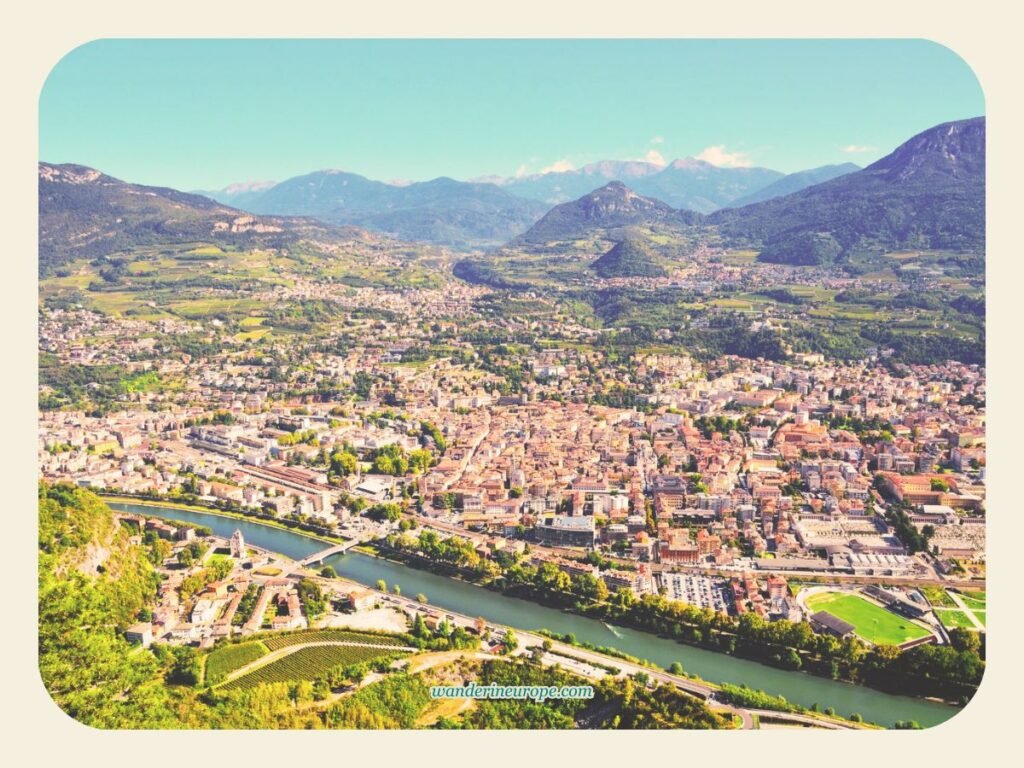
We mentioned Doss Trento earlier as one place to take in the city’s panoramic views. There’s another option: Sardagna, a village perched above the rocky outcrop to the west of Trento’s city center.
How does it compare to the view from Doss Trento? While it’s only slightly higher, you can see the mountains to the north from there.
What makes the observation deck in Sardagna better than Doss Trento? There’s a cozy café nearby, and the cable car makes it easy to get there without breaking a sweat. It’s the perfect spot to relax and spend time with friends or loved ones. If you’re interested in a gondola ride, it’s less than 10 EUR per person.
To check if the gondola is running or to find its operating hours, simply visit the official website of Trentino Transport.
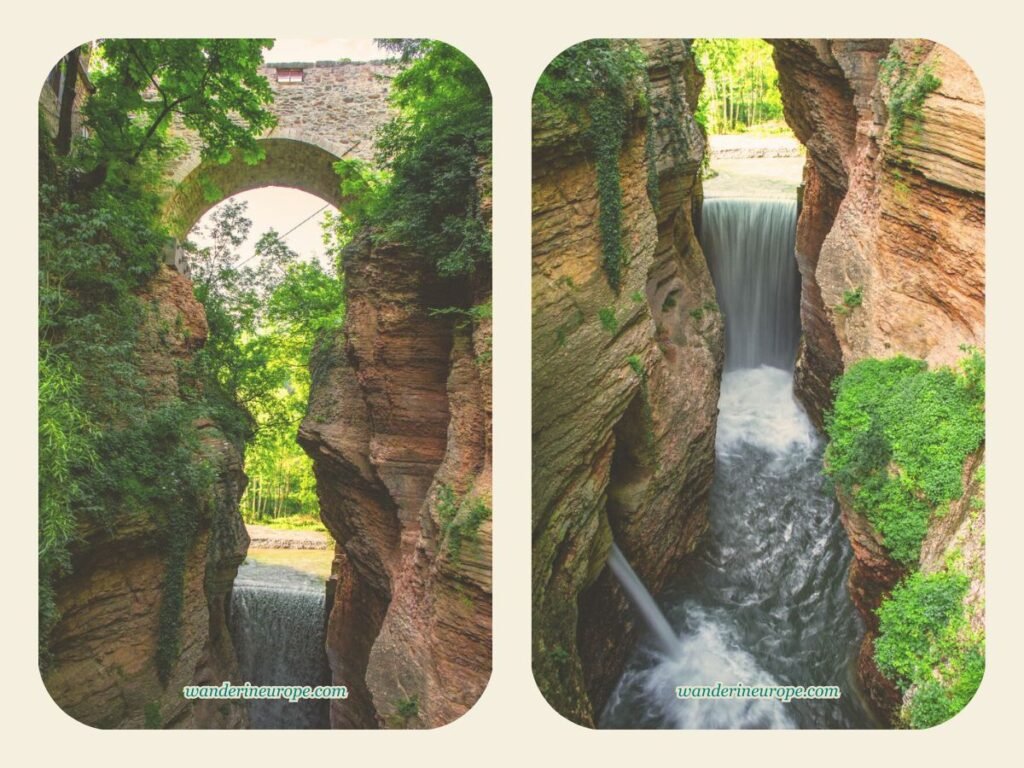
Like many towns in the Alps, Trento offers a scenic landscape full of surprises. One example is the Orrido di Ponte Alto gorge, which reflects both the beauty of nature and human ingenuity.
Over thousands of years, the Fersina stream carved through the rocks and shaped the gorge into a natural masterpiece. However, heavy rains would cause the stream to swell, flooding the city of Trento. To protect the city from these floods, the residents stepped in and engineered a solution that transformed the gorge.
Today, visitors can see two massive 40-meter waterfalls cascading into the winding chasm, creating a striking curtain of water. The gorge walls, marked with patterns from centuries of erosion, tell a story that adds to the experience.
Though the gorge is located 4 kilometers from the city, a quick bus ride or a Google Map route (which you can find at this link) will take you right to the site.
- From Trento train station, hop on bus #9 and drop by Cognola Grezoni.
- From Cognola Grezoni station, proceed to Via Grezoni. You shall find road signs directing you to Via Grezoni once you alight the bus.
- When you reach the end of Via Grezoni, you arrive at Via Ponte Alto and turn left.
- Walk along with Via Ponte Alto without turning to any other streets.
- Continue walking for about 10 to 12 minutes, and you shall find an old restaurant with “CASCATA di PONTE ALTO” written on its facade. The restaurant is also called La Gnoccata.
- Beside La Gnoccata is the entrance to the Orrido di Ponte Alto.
Beside La Gnoccata and the sports complex along Via Ponte Alto, you’ll find a parking lot. However, I highly recommend taking the train to avoid the hassle of finding a parking space.
Before visiting, I strongly suggest checking the announcement page to stay updated on any changes or closures.
Day Trips from Trento
If you’re using Trento as your home base to explore Northern Italy or the Italian Alps, many exciting and adventurous destinations are easily accessible from the city. Here’s what I’ve found!
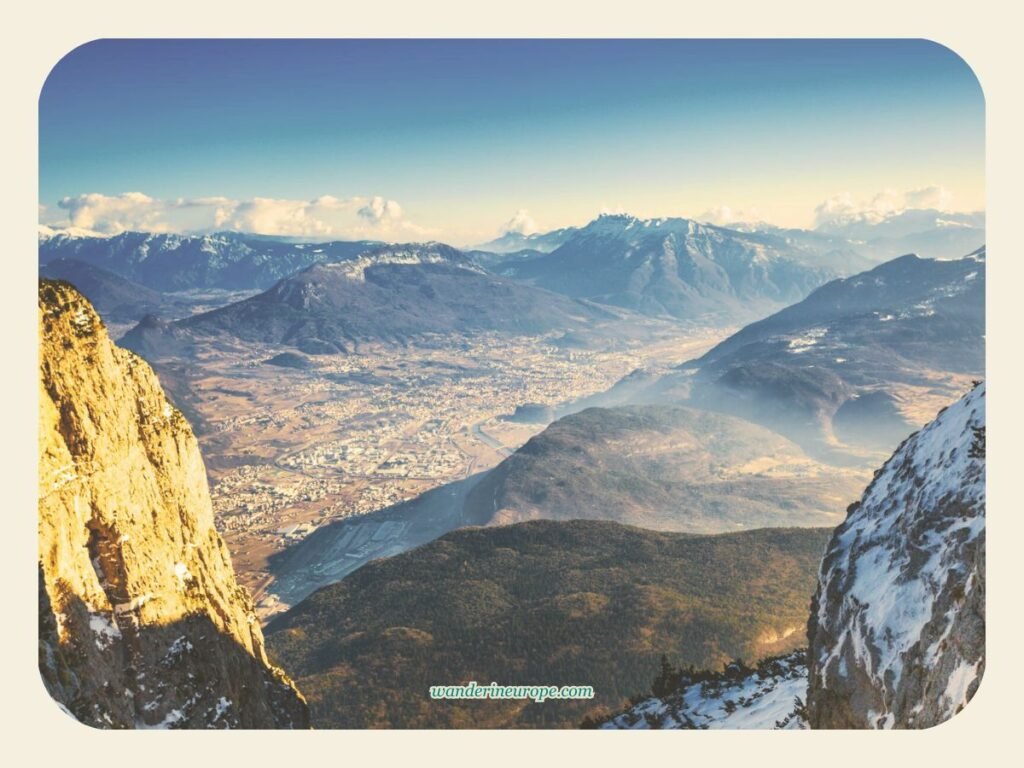
Paganella is a popular peak for anyone traveling from Trento. Standing at 2,124 meters, it sits in the heart of Trentino and offers a 360-degree view of the region. From here, you can see many parts of the Italian Alps, including Lake Garda, the Brenta Dolomites, Adige Valley, and Pale di San Martino. The rugged peaks of the Dolomites are a sight worth seeing.
But Paganella offers more than just the view. Its slopes are great for skiing in the winter and hiking in warmer months, making it a year-round spot for outdoor lovers of all ages and experience levels. When it’s time to rest, you can stop by a café or lodge to enjoy tasty food and drinks while taking in the beautiful scenery. Both your eyes and your appetite will be happy.
Reaching the top of Paganella doesn’t require a tough hike. From Andalo, the closest town, you can take a cable car straight to the summit. To get to Andalo from Trento, just hop on bus #B611 at the train station—it’s about a 1-hour and 9-minute ride.
For more travel options, you can check out the Trentino Transport website.
Andalo has lots of attractions, including amusement parks, mountain parks, and water parks, that you can check out before heading to Cima Paganella. If you’re traveling with kids, they’ll definitely have fun at the Andalo Life amusement park!
The mountains provide an incredible view of stars and distant galaxies. With no light pollution, the stars shine more brightly here than almost anywhere else. For this reason, MUSE, an astronomical observatory, built its facility in the Viote basin near the top of Monte Bondone, far from the city center.
Known as Terrazza Delle Stelle, or Terrace of the Stars, the observatory features powerful telescopes, including an 80 cm Newtonian reflector. Expert guides help visitors use the telescopes to view stars beyond our galaxy at night, while special filters allow safe observation of the sun during the day.

At its heart is a polished steel dome that offers amazing views of the surrounding landscape and the night sky. The dome’s reflective surface looks like a drop of mercury atop an elevated valley, catching the light in a way that’s mesmerizing any time of day.
Admission is completely free, making it accessible to everyone. Nearby, there’s also a botanical garden and a fun amusement center. If you need a quick snack, you can stop by the cafe near Terrazza Delle Stelle.
If you’re looking to explore the instruments on site, be sure to check for events or schedule an appointment ahead of time by reaching out to MUSE through their website or email at astronomia@muse.it. Events are also announced on their official Facebook page.
Terrazza Delle Stelle is in the mountains, but it’s easy to reach with just one bus ride. Take the B202 bus straight to the observatory. You can hop on the bus from Trento train station and get off at Viote. You can check the schedule and availability of the bus on the Trentino Transport website.
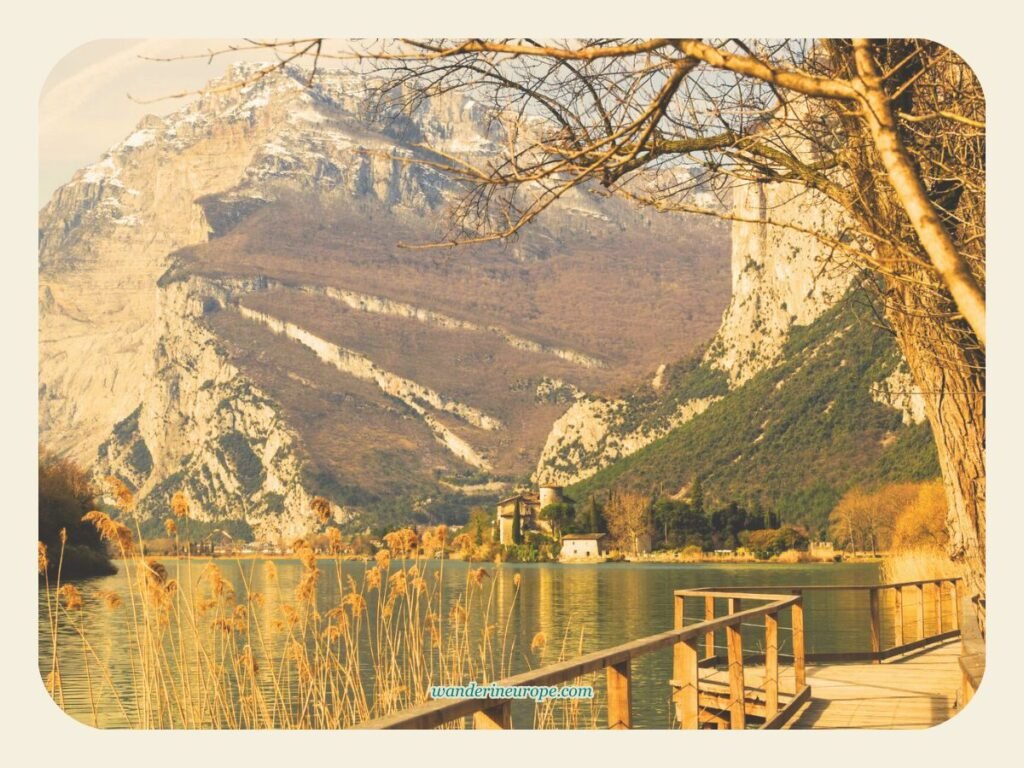
Castel Toblino is one of the most magical places you can visit near Trento. Its fairytale-like setting is unforgettable. There are two key reasons to visit: its fascinating history and its incredible location.
The castle’s history dates back to the 16th century when a fortress was built on a promontory in Lake Toblino. However, its legends go back over 2000 years, with stories claiming that fairies once lived by the lake and that the castle replaced a temple dedicated to them. Let’s talk about the vibes!
But what really makes Castel Toblino worth visiting are the beautiful mountains and calm lake around it. Head to the viewpoint for an unforgettable view of the castle reflected in the water, with a towering mountain in the background. It’s a view that will stick with you!
Castel Toblino’s beauty isn’t just on the outside. Inside, you’ll find impressive frescoes and paintings of musical instruments in the music hall, along with various medieval artifacts. While it may not be as grand as some other Italian castles, it has a nostalgic and enchanting feel.
As you explore, you’ll come across armored statues, iron doors, inscriptions, carpets, and more, each adding to its unique character. If you get hungry, the castle’s restaurant serves delicious food, though it can be a bit pricey. Still, the views and atmosphere make it worth it—especially on hot, sunny days when their refreshing drinks are hard to resist.
Keep in mind that the castle doesn’t accept walk-in visitors right now, so you’ll need to book a date and time in advance. You can email the castle’s administrator at associazionecasteltoblino@gmail.com or check their website for the latest updates and hours.
Even if you can’t go inside, the area around the castle is worth exploring. Lake Toblino has some great hiking trails, many of which are paved for easy walking, plus plenty of boardwalks—perfect for snapping photos!
Visiting Lake and Castel Toblino is super easy! It’s just one bus ride from Trento—take bus #B201 from the train station and get off at the Castel Toblino stop, which takes around 30 minutes. If you’re coming from somewhere else, buses #B204, #B205, and #B215 also stop at Castel Toblino.
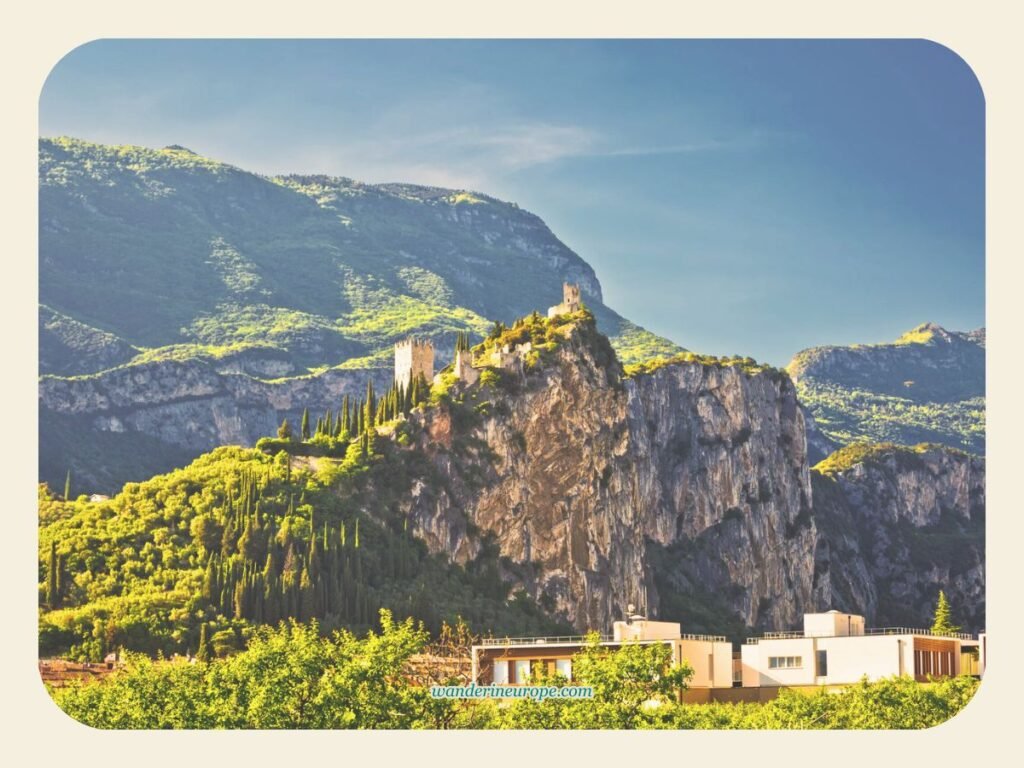
If you want to explore another castle from Trento, check out Castel Arco in Arco. Unlike Castel Toblino, it sits on a hilltop with amazing views both from a distance and up close. Even though the castle is in ruins, that’s part of what makes it special. Walking through its broken walls, arches, and stairways can make you feel like you’ve traveled back in time.
The view from Castel Arco feels like something out of a movie, with dramatic sights that will satisfy your travel cravings. From the castle’s top, you can see a panoramic view of Arco, nearby fields and mountains, and even Lake Garda in the distance.
While some parts of the castle have crumbled with time, the tower, old halls, and prison are well-preserved. Don’t miss the frescoes on the castle walls—they feature knights, court ladies, noblemen, and Saint George defeating a dragon.
Before you go, be sure to check the visitor’s information page of Arco Castle for any announcements, updates, or requirements.
To get to Arco Castle from Trento, take bus #B205 from the Trento Train Station toward Arco P. Foro Boario. The ride takes about an hour. Once you arrive, follow the path up the hill to the castle—it’s just a 17-minute walk. For bus schedules and other routes, check the Trentino Transport website.
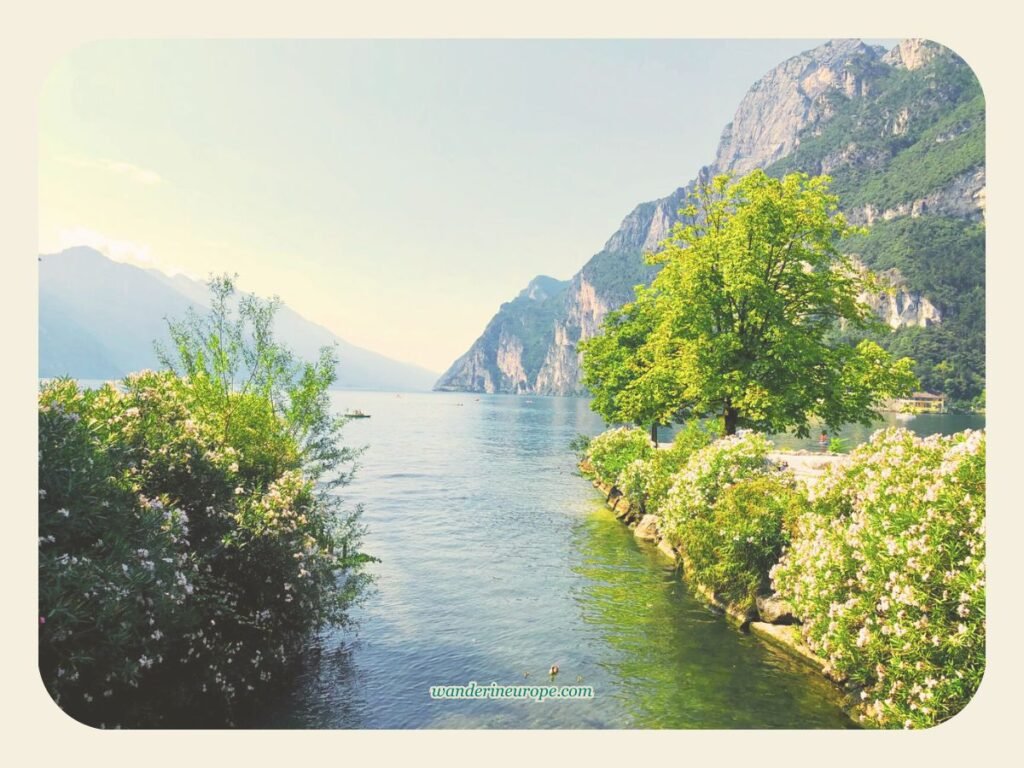
The northern shore of Lake Garda feels like a little slice of paradise. With its beach, beautiful views, scenic hiking trails, charming landmarks, and romantic restaurants, it’s easy to see why visiting Lake Garda is a top choice from Trento. If you’re heading there, make sure to pack your swimsuits!
The beaches at Lake Garda are beautiful, and the towering limestone mountains rising above the lake are breathtaking. There are plenty of fun activities and water sports to try, like canoeing, kayaking, and boating. If you love photography, this place is perfect. From photogenic docks to cute ducks, there’s always something to snap—especially on sunny days.

Lake Garda is Italy’s largest lake, covering 370 square kilometers (143 square miles) with plenty to explore all around. You can take boat tours to check out the beautiful spots along the lake. On the northern shore, you’ll find the towns of Riva del Garda and Nago-Torbole. If you’ve visited Arco Castle, these towns are just a short 15- to 20-minute drive away.
- Bus #B863 – Arco to Riva del Garda
- Bus #484 – Riva del Garda to Torbole
Going to Lake Garda straight from Trento? Hop on bus #B205 or #B301 from the Trento station and drop by Riva Del G. Autostaz. It’s an hour and 30 minutes of travel time. You can check the bus schedule and alternative routes from the Trentino Transport website.
To find the best experiences and landmarks around Lake Garda, check out my guide or this three-day Lake Garda itinerary.
If you want a unique experience in Trento, check out Arte Sella. This outdoor art museum features contemporary pieces made from natural materials. The exhibits are captivating, and you’ll likely want to take pictures of everything. Since it’s hard to describe each artwork, I’ve added a video below to give you a preview of what Arte Sella has to offer:

Art Sella is located in the town of Borgo Valsugana, about 40 kilometers east of Trento. There’s no public transportation to the park, so the only way to get there is by car, which takes about an hour from Trento. If you’re planning a visit, check the “How to Reach Us” page on Art Sella’s website for details on parking, taxi options, bike rentals, and more. Also, make sure to review their Rates and Schedules page and any announcements or requirements before heading out.
From great hotel deals to skip-the-line tickets and affordable eSim to cheap rentals, click here for the best hotel deals and more travel discounts.
Map of Attractions
I’ve put together a map to show you exactly where the places of interest and day trips from Trento are. You can zoom in and out for a closer look at each spot.

Go Beyond Trento
When you’re in Trento, you’re in one of the most beautiful regions in Europe: Northern Italy. Don’t miss the chance to check out its incredible sights and landmarks. Start exploring with WanderInEurope’s Northern Italy bucket list. The three closest destinations to visit are Bolzano, the Dolomites, and Verona.
For a convenient, unique, or more enriching visit, check out these experiences and services:


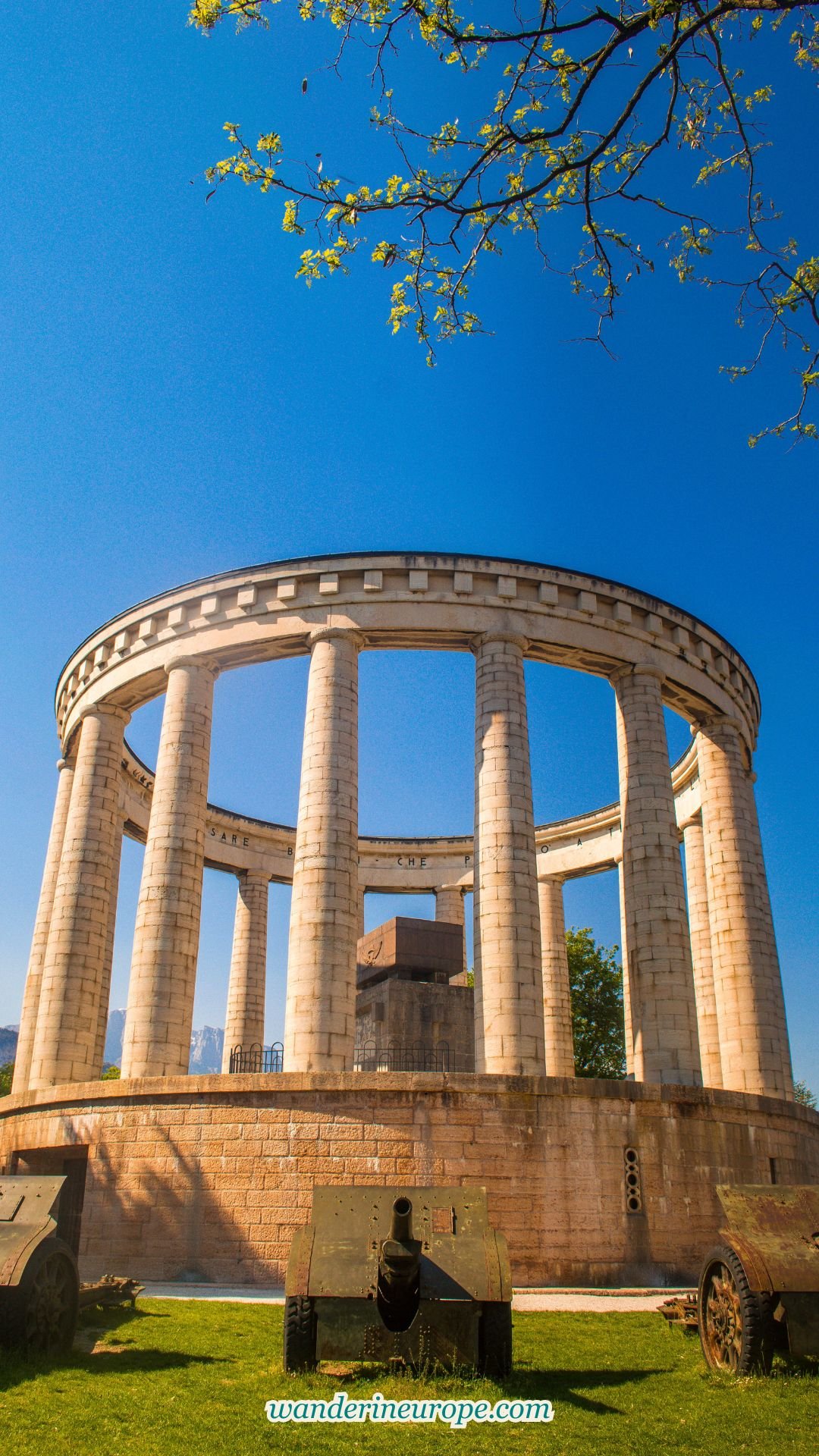
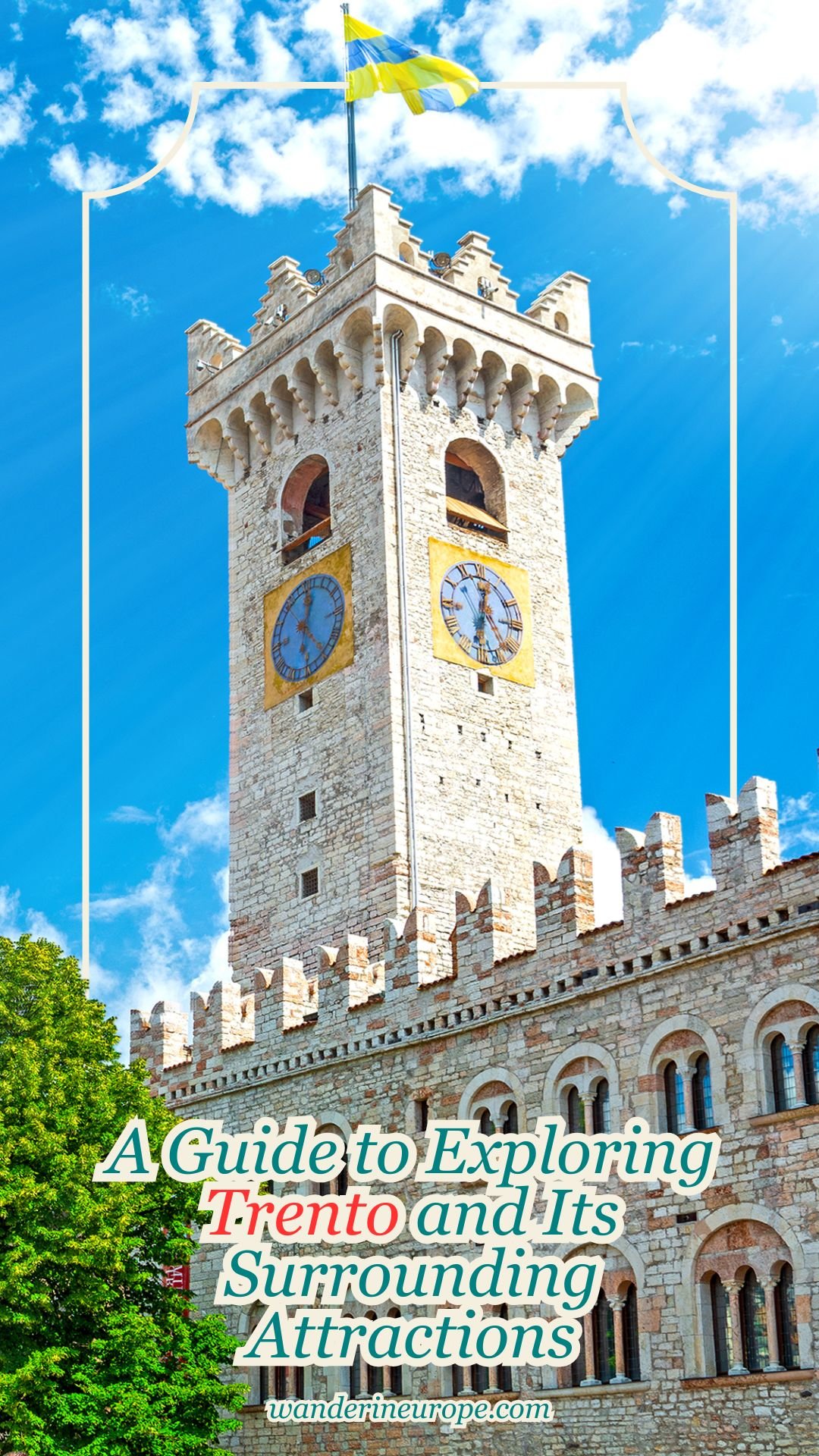
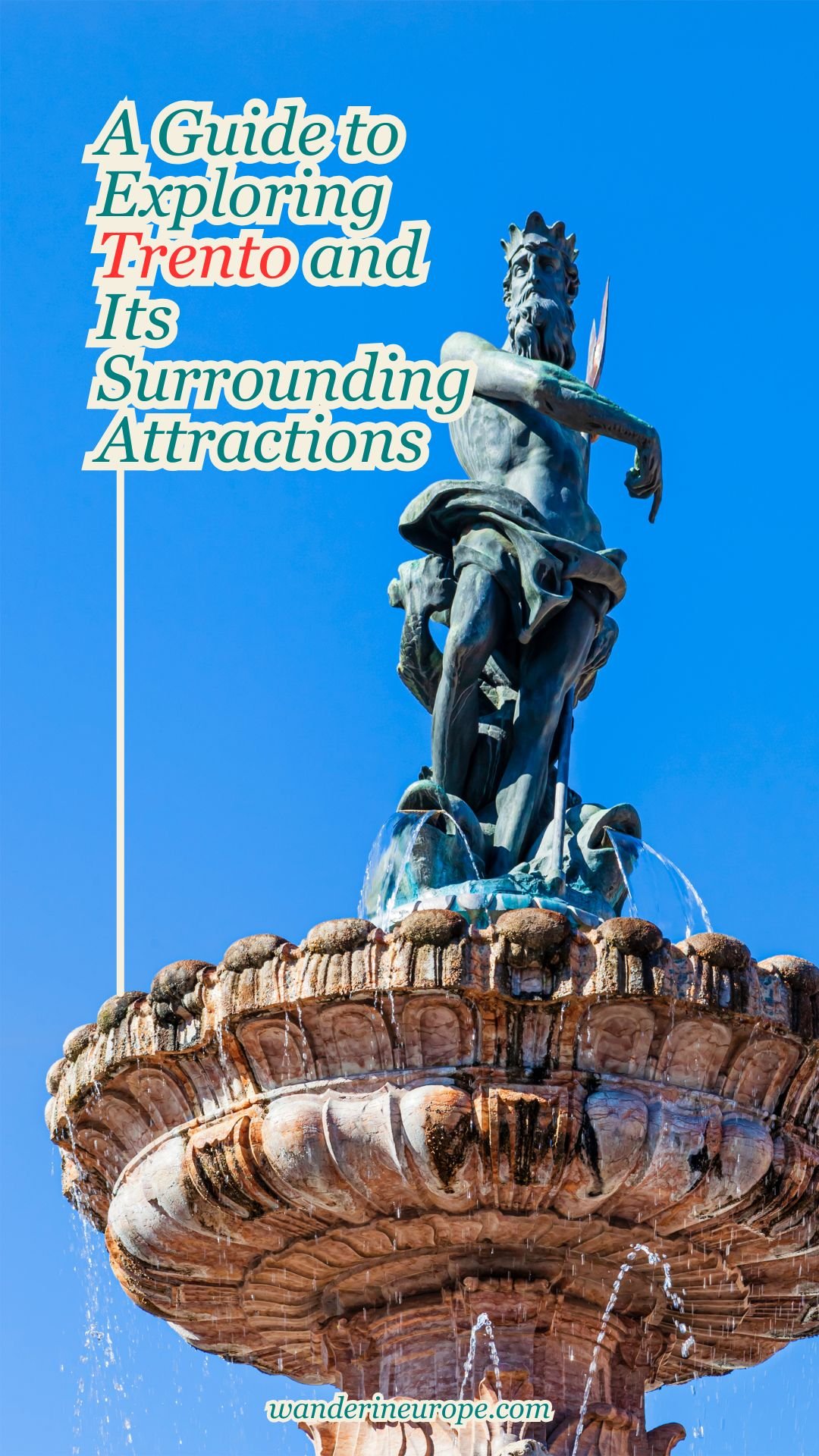
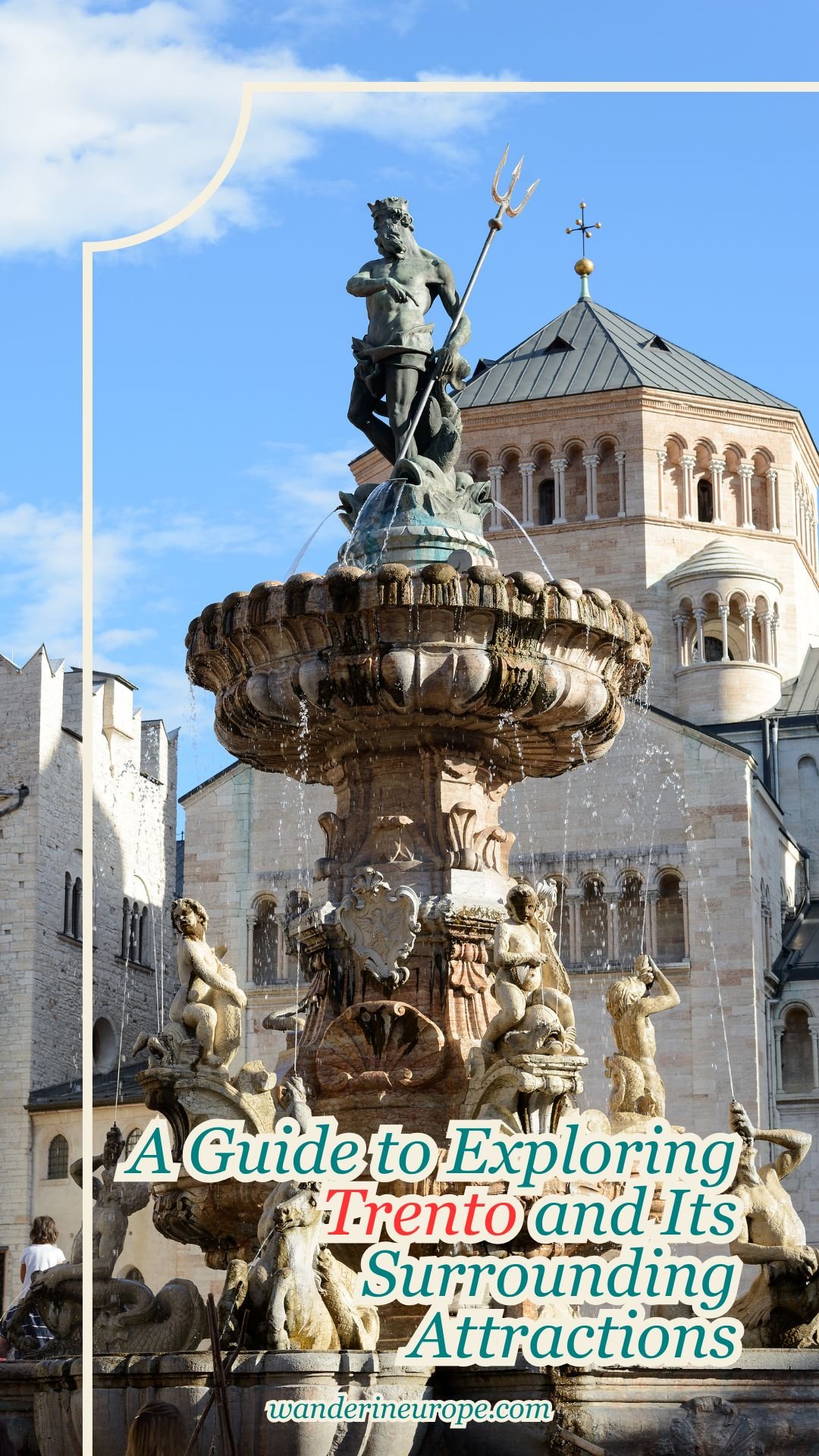
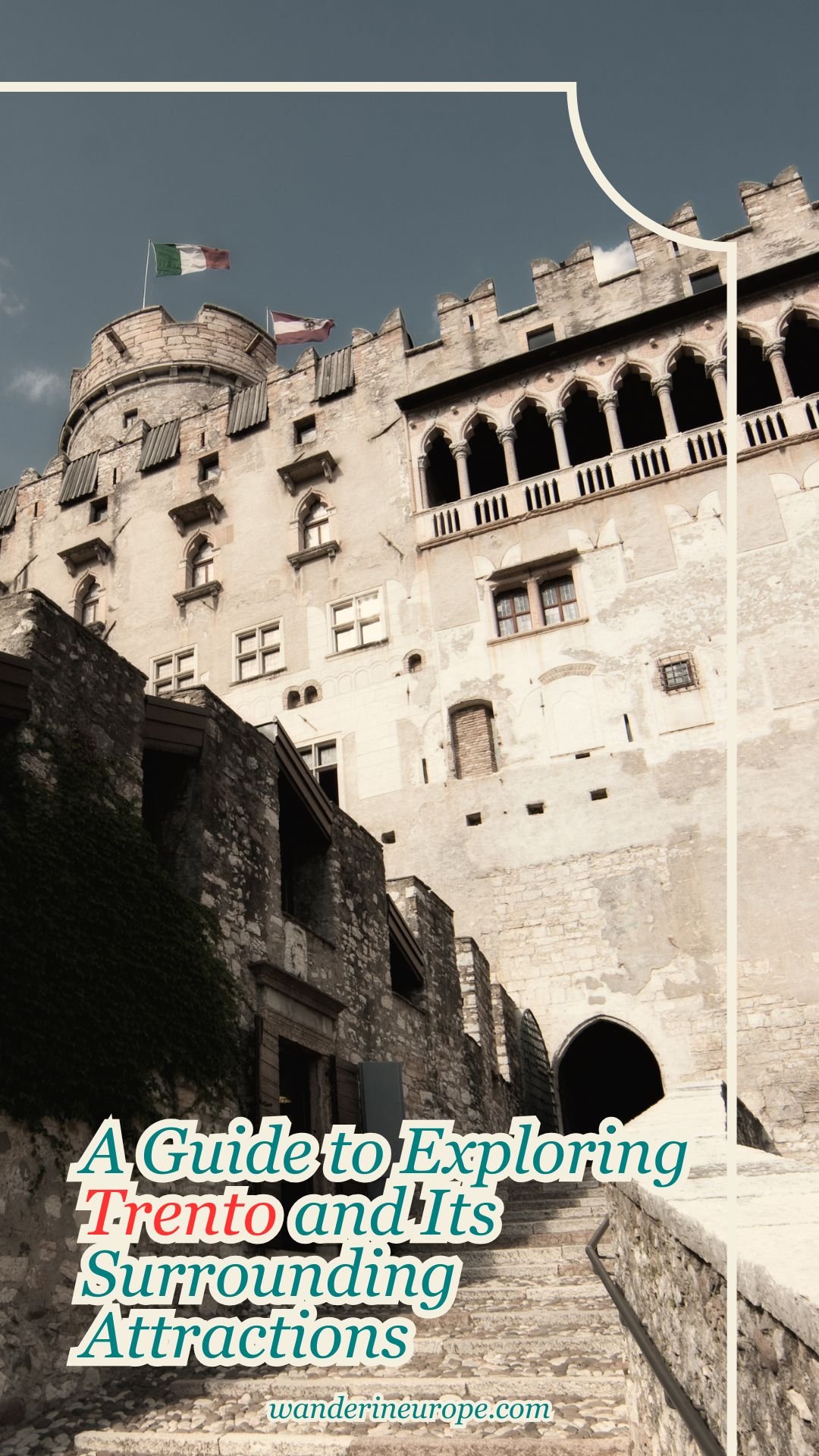
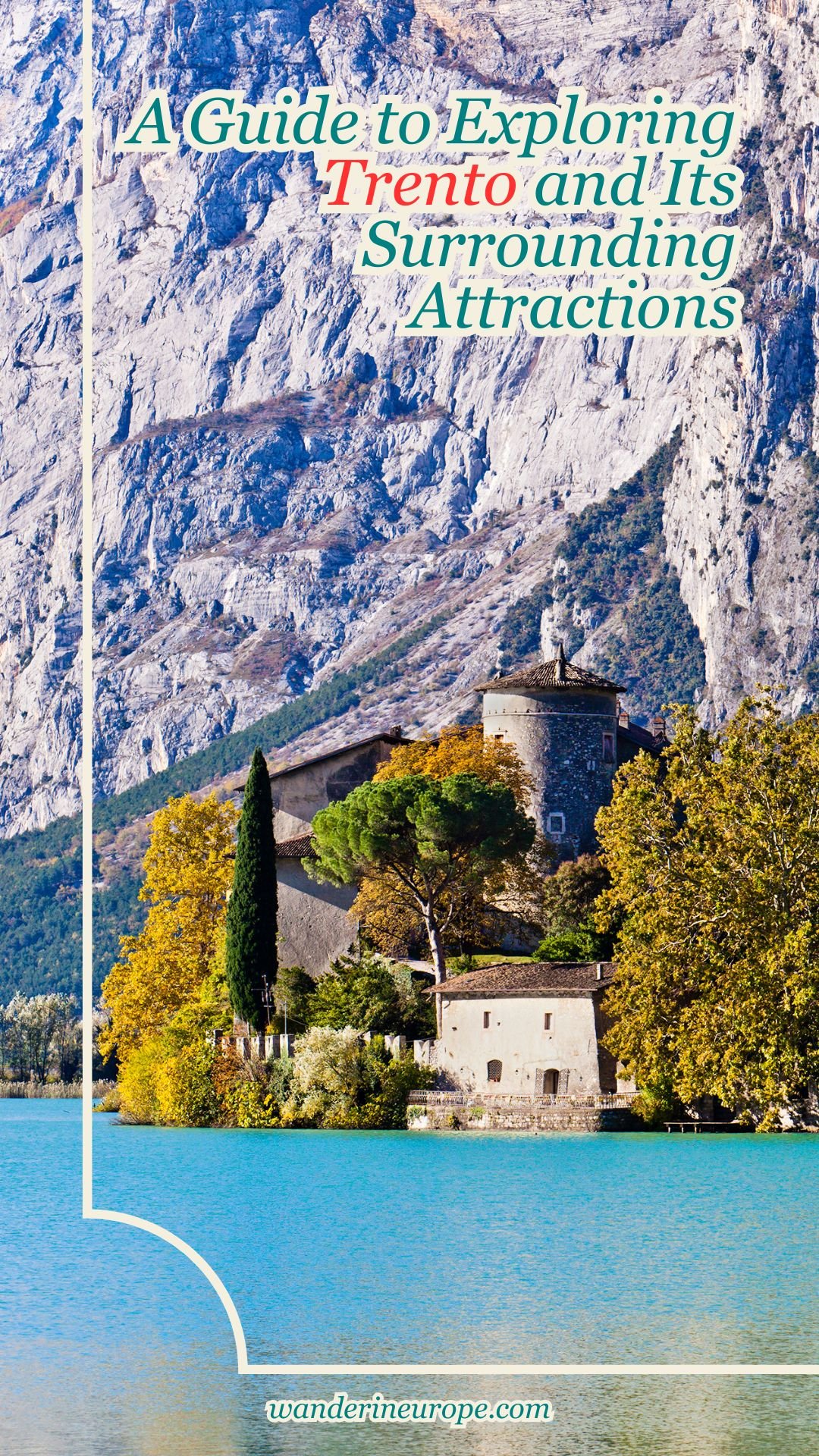
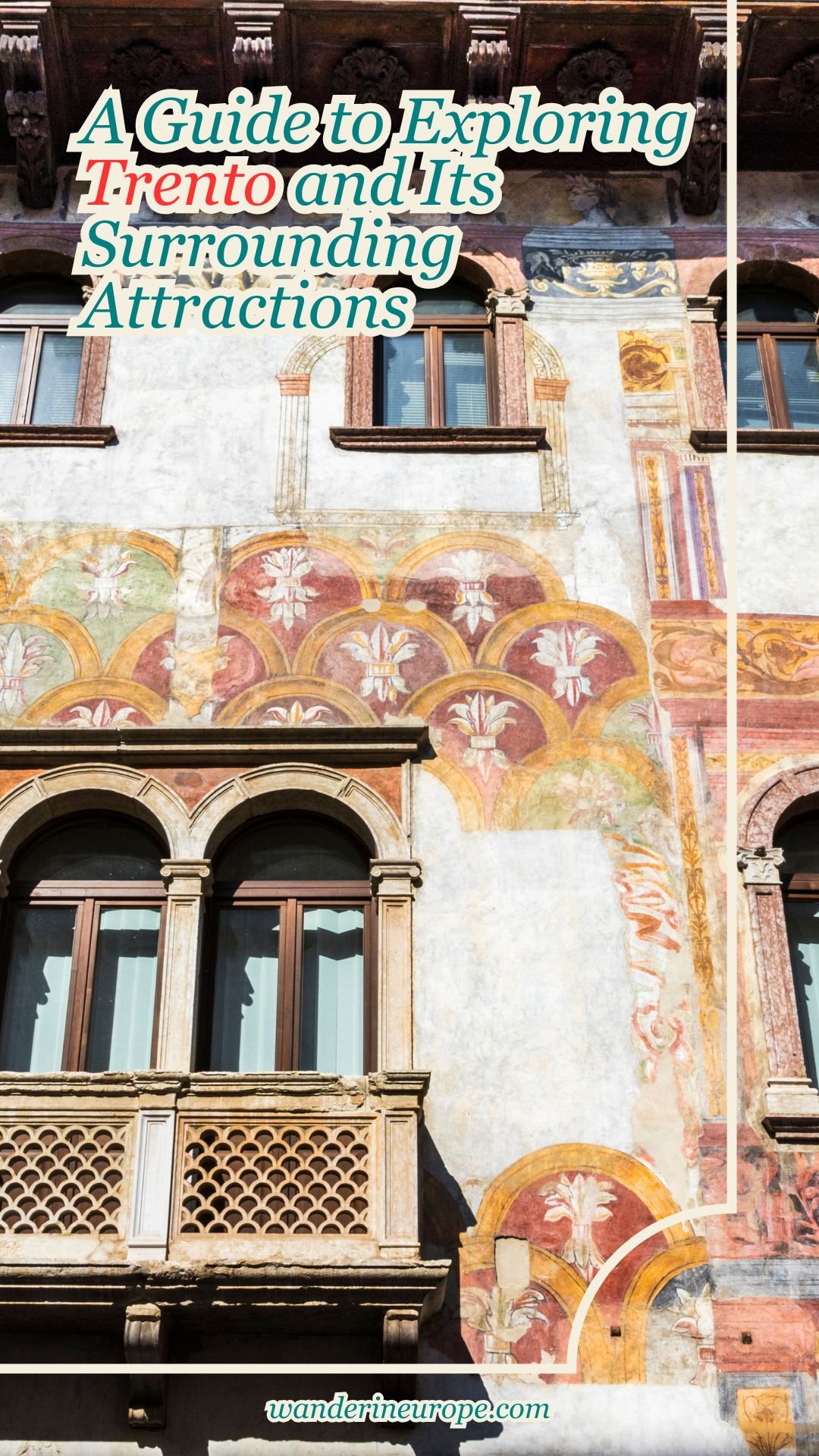
Pin this to save it for later or bookmark it to read anytime.

